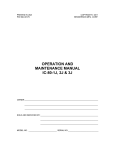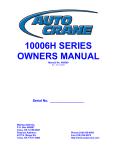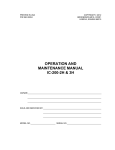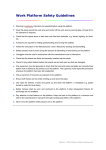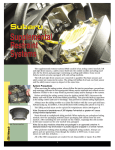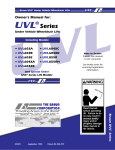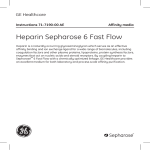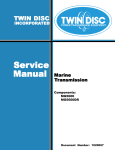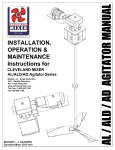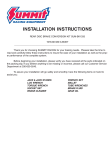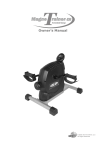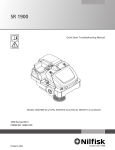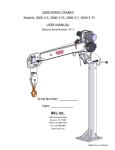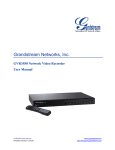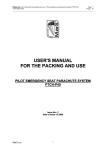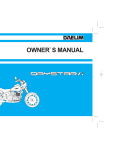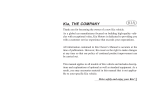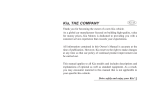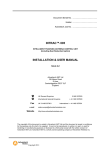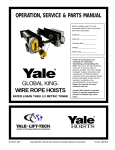Download OPERATION AND MAINTENANCE MANUAL IC-35-2F
Transcript
PRINTED IN USA
P/N 990-30168
COPYRIGHT 2011
BRODERSON MFG. CORP.
OPERATION AND
MAINTENANCE MANUAL
IC-35-2F
OWNER: _________________________________________________________________________
_________________________________________________________________________
_________________________________________________________________________
SOLD AND SERVICED BY: _________________________________________________________
_________________________________________________________
_________________________________________________________
MODEL NO. ___________________________ SERIAL NO. ______________________________
BRODERSON MANUFACTURING CORP.
STATEMENT OF WARRANTY FOR MOBILE CRANES
Broderson Manufacturing Corp. ("BMC") warrants its products to be free from defects in material or workmanship at the date of
shipment from BMC. This warranty shall be effective only when validated by the return to BMC of it’s standard form of Warranty
Validation Certificate, duly completed and signed by the original purchaser from BMC and any subsequent purchaser who buys a
BMC product as a new product, and then only as to defects reported to BMC in writing within 1 year or 2000 hours, whichever
occurs first, from the date a product is placed in service, as evidenced by such warranty validation certificate. THIS WARRANTY
APPLIES TO ALL PARTS OF BMC'S PRODUCTS EXCEPT ENGINES, DRIVE TRAINS, HYDRAULIC SYSTEM
COMPONENTS, OR ACCESSORY EQUIPMENT, WITH RESPECT TO WHICH BMC MAKES NO WARRANTY OF
MERCHANTABILITY OR FITNESS FOR A PARTICULAR PURPOSE AND NO OTHER WARRANTY OF ANY KIND,
EXPRESS OR IMPLIED; the sole warranties, if any, with respect thereto being those made by the respective manufacturers
thereof.
THE SOLE REMEDY FOR BREACH BY BMC OF THIS WARRANTY SHALL BE THE REPLACEMENT OF ANY PARTS OF
ITS PRODUCTS WHICH WERE DEFECTIVE AT THE DATE OF SHIPMENT OR, IF (AND ONLY IF) REPLACEMENT OF
DEFECTIVE PARTS IS IMPOSSIBLE OR IS DEEMED BY BMC TO BE IMPRACTICAL, REPLACEMENT OF THE ENTIRE
PRODUCT OR, AT BMC'S OPTION, REFUND OF THE PURCHASE PRICE. The replacement remedies include labor in
connection with the removal of defective parts and the installation of their replacements, as well as the cost of delivery and
transportation of defective products or parts and the replacements thereof. The sole purpose of these remedies is to provide the
purchaser with free replacement of defective parts or, in the limited circumstances specified, replacement of the entire product or
a refund of the purchase price. These exclusive remedies shall not be deemed to have failed of their essential purpose so long
as BMC is willing and able to replace defective parts or the entire product or to refund the purchase price. The remedies herein
provided shall be available only if BMC is given reasonable access to the product, including all allegedly defective parts,
promptly after the defect is discovered. BMC shall have the right to return any allegedly defective parts to its plant or any other
location selected by it, for inspection and testing to determine whether they were defective at the date of shipment, prior to
replacement thereof.
The warranty herein made is extended only to the original purchaser from BMC and any subsequent purchaser who buys a BMC
product as a new product. WITHOUT LIMITING THE GENERALITY OF THE FOREGOING, BMC EXPRESSLY DISCLAIMS
THAT THE WARRANTY MADE HEREIN EXTENDS TO A PERSON WHO RENTS OR LEASES ANY BMC PRODUCT OR
WHO PURCHASES ANY BMC PRODUCT AS A USED PRODUCT. For purposes hereof, a BMC product shall conclusively be
deemed "used" after the expiration of twelve (12) months from its placement in service, as evidenced by a duly completed and
signed warranty validation certificate actually received by Broderson, or after such earlier time as it has been operated for more
than one hundred (100) hours. BMC shall have no liability hereunder with respect to products which have been subjected to
misuse, negligence, accident or other external forces which may have caused or accentuated any apparent failure of such
products to conform to the warranty herein made.
BMC does not warrant any of its products to meet any state, local or municipal law, ordinance, code, rule or regulation. The
purchaser must assume the responsibility for maintaining and operating the products which are the subject of this warranty in
compliance with such of the foregoing as may be applicable, and BMC shall not be liable for the purchaser's failure to meet such
responsibility.
THE WARRANTY HEREIN MADE IS IN LIEU OF ANY OTHER WARRANTY, EXPRESS OR IMPLIED. BMC MAKES NO
WARRANTY OF MERCHANTABILITY OR FITNESS FOR A PARTICULAR PURPOSE, OR ANY OTHER EXPRESS OR
IMPLIED WARRANTY OF ANY KIND, TO ANY PURCHASER, LESSEE OR RENTER OF NEW OR USED BMC PRODUCTS
OR ANY OTHER PERSON WHATSOEVER. NO PERSON IS AUTHORIZED TO ACT ON BEHALF OF BMC IN MODIFYING
THE WARRANTY HEREIN MADE OR IN MAKING ANY ADDITIONAL OR OTHER WARRANTY.
IN NO EVENT SHALL BMC BE LIABLE FOR INCIDENTAL OR CONSEQUENTIAL DAMAGES OF ANY KIND
WHATSOEVER.
THIS EXCLUSION OF INCIDENTAL AND CONSEQUENTIAL DAMAGES IS INTENDED TO BE
INDEPENDENT OF ALL OTHER PROVISIONS OF THIS STATEMENT OF WARRANTY AND SHALL BE GIVEN FULL
EFFECT NOTWITHSTANDING THE UNENFORCEABILITY OR FAILURE OF THE ESSENTIAL PURPOSE OF ANY OTHER
PROVISION OF THIS STATEMENT OF WARRANTY.
THE FOREGOING DISCLAIMERS OF WARRANTIES AND DISCLAIMER OF LIABILITY FOR INCIDENTAL OR
CONSEQUENTIAL DAMAGES SHALL BE EFFECTIVE REGARDLESS OF WHETHER THE EXPRESS WARRANTY
CONTAINED HEREIN BECOMES EFFECTIVE AS PROVIDED IN THE FIRST PARAGRAPH HEREOF.
Document Number: WI-SM-002 Rev A
Effective: August 1, 2009
IC-35-2F Operation and Maintenance Manual Addendum for Drum Rotation
Indicator
Drum Rotation Indication (DRI) is a new feature added to Broderson
Manufacturing Corp. cranes shipped after November 1, 2011. The following
information in bold is supplemental to the Operation and Maintenance Manual.
Section 1, Description and SpecificationsOperator's Compartment Standard features:
Drum Rotation Indicator:
Provides tactile feedback to operator when hoist drum is rotating.
Feedback device attached to hoist control handle. Feedback is
proportional to hoist speed.
Section 3, MaintenanceOPERATOR INSPECTION AND TEST
An operator, in the course of normal operation, should make certain observations,
inspections and tests to assure that the unit is ready and able to perform safely.
Daily:
1. Check radiator coolant level.
2. Check engine oil level.
3. Check general condition of tires.
4. Visually inspect for loose pins and physical damage.
5. Check fuel level.
6. Check engine oil pressure.
7. Check engine coolant temperature.
8. Check battery charging amperage.
9. Check hydrostatic transmission temperature.
10. Check hydrostatic transmission control switch and accelerator operation.
11. Check parking brake operation.
12. Check power steering operation.
13. Observe chassis for normal driving operation.
14. Observe boom operation for normal power and speed.
15. Check load line and hooks for damage.
16. Check condition of sheaves and load line retainers.
17. Check hydraulic oil level.
18. Check anti-two-block system for proper operation.
19. Check back-up alarm for proper operation.
20. Check operation of Rated Capacity Limiter according to the RCL User Manual.
21. Check hydraulic hoses, particularly those that flex during crane operation.
22. Check the outrigger warning light for proper operation as described on page 2-9.
23. Check that the Drum Rotation Indicator is functioning.
Ref. Addendum part number 990-30197
TABLE OF CONTENTS
SECTION 1
DESCRIPTION and SPECIFICATIONS
Introduction………..………………………………………… 1-1
Dimensions and Orientation IC-35-2F………..…………… 1-2
Turning Dimensions………..……………………………… 1-3
Description and Specifications………..…………………… 1-4
SECTION 2
OPERATION
Safety Rules………...……………………………………… 2-1
Instruments and Controls………..………………………… 2-5
Control Functions…………………………………… 2-5
Sequence of Operation………..…………………………… 2-6
Driving the Vehicle……….………………………… 2-6
Operating the Crane……...………………………… 2-7
Normal Gauge Readings……….…………………… 2-7
Rated Capacity Limiter……………………………… 2-8
Crane Capacity………..…………………………………… 2-9
Crane Capacity Example……...………………...… 2-11
Crane Capacity Chart IC-35-2F………….…………2-12
Crane Capacity Chart IC-35-2F Metric………….…
2-12M
Sheave Block and Downhaul………...…………………… 2-13
Two-Part-Line Reeving……….…………………………… 2-14
Safety Devices………...…………………………………… 2-15
Optional Equipment Operation………...………………… 2-16
Boom Extension……...………………………………2-16
Front Auxiliary Winch…………………………….. 2-17
Switch and Indicator Symbols on BMC Cranes………... 2-18
SECTION 3
MAINTENANCE
Safety Rules………...……………………………………… 3-1
Inspection and Testing Checklists………...……………… 3-3
Maintenance Checklist………...…………………………… 3-5
Lubrication………...………………………………………… 3-7
Rotation Bearing……….…………………………… 3-7
Torque Hub Lubrication……….…………………… 3-7
Wire Rope…...…..…………………………………… 3-7
Lubrication Chart and Schedule……….…………… 3-8
Hoist Cable Installation and Inspection………...…………3-10
Hydraulic System Description………...……………………3-13
JIC Schematic………..……………………………… 3-12
JIC Schematic Metric..………………………………
3-12M
Steering System……….…………………………… 3-13
Propulsion System……….………………………… 3-15
Hydraulic System Maintenance………...………………… 3-17
Transmission Start-Up Procedure……….…………3-17
Transmission Troubleshooting……….…………… 3-19
Care of Hydraulic Oil……….…………………………3-20
Hydraulic Oil Specifications……….…………………3-21
SECTION 3
MAINTENANCE (cont'd)
Hydraulic System Maintenance………...………………… 3-17
Purging the Hydraulic System……….………………3-21
Bleeding the Brakes……..…………...………………3-23
Hydraulic Seals………..………………………………3-24
Hydraulic System Adjustments………….…………………3-25
Control Valves………..……………………………… 3-25
Boom Cylinder Holding Valve………..………………3-26
Extension Cylinder Holding Valve………..…………3-26
Engine Maintenance……….....…………………………… 3-27
Air Cleaner Service……...……………………………3-27
Cooling System………..………………………………3-27
Spare Parts List………..…………………………… 3-27
Major Engine Servicing………...……………………3-27
Mechanical Adjustments………...….………………………3-28
Fasteners………...……………………………………3-28
Rotation Gearbox………...………………………… 3-28
Wheel Bearings………...…………………………… 3-28
Wheel Alignment………..……………………………3-28
Torque Data………..…………………………………3-29
BRODERSON MANUFACTURING CORP.
IC-35 INDUSTRIAL CRANE
INTRODUCTION
The Broderson IC-35 was designed and built to provide safe, dependable and efficient
crane service. This we assure by our testing and quality control procedures. To
properly utilize the full potential of the equipment, the following customer controlled
conditions must exist:
1. The operator must understand the equipment.
2. The operator must know the operating characteristics.
3. The operator must observe the safety rules.
4. The equipment must be given proper maintenance.
This manual was written to provide information required for these conditions. The
recommendations for periodic inspection, test and maintenance are minimum standards
for safe and economical performance.
When ordering parts, the unit serial number, unit model number, part number, part
description and quantity must be provided.
This unit must not be altered or modified without written factory approval.
To reorder this manual, ask for IC-35-2F Operation and Maintenance Manual Part
Number 0-990-30168. Contact your Broderson service representative at:
Broderson Manufacturing Corp.
P.O. Box 14770
Lenexa, Kansas 66285 USA
913-888-0606
NOTICE
If this crane becomes involved in an accident, please call Broderson Manufacturing Corp.
at 913-888-0606, and ask for the Legal Department or the Service Manager. Also,
please notify your Broderson dealer.
1-1
DIMENSIONS AND ORIENTATION IC-35-2F
1-2
TURNING DIMENSIONS
1-3
SECTION 1
DESCRIPTION AND SPECIFICATIONS
BMC’s IC-35-2F is a self-propelled industrial crane designed for in-plant lifting and
material handling applications. It has the special features of low height, narrow width,
short length, cargo deck, rear wheel steer, and front wheel drive. The basic unit consists
of a chassis and hydraulic boom assembly. The chassis includes a frame, four hydraulic
outriggers, engine, variable speed hydrostatic transmission, front driving and rear power
steering axles. The boom assembly includes a hydraulic powered continuous rotation
turret, 3-section telescopic boom, hydraulic boom elevating cylinder, hydraulic boom
extension cylinders and hydraulic powered hoist. A Rated Capacity Limiter is also
standard.
IC-35-2F:
3-section hydraulically extended boom with capacity of 8,000 pounds (3629 kg) at
a 4-foot (1.2 m) load radius. Horizontal reach of 19 feet 2 inches (5.84 m) and
vertical reach of 26 feet (7.92 m). Hoist is located on back of turret.
GENERAL:
Length:
Chassis
Overall
9 feet 11 inches (3.02 m)
11 feet 11 inches (3.63 m)
Width:
5 feet 0 inches (1.52 m)
Height:
Deck
Overall
28 inches (71.12 cm)
6 feet 6 inches (1.98 m)
Wheelbase:
6 feet 0 inches (1.83 m)
Ground Clearance:
Chassis
Minimum (Rear Axle)
7 inches (17.78 cm)
5 inches (12.7 cm)
Angle of Approach:
26 degrees
Angle of Departure:
21 degrees
Turning Radius: (Min.)
11 feet 2 inches (3.40 m)
Aisle Width: 90 degree Turn (Min.)
8 feet 3 inches (2.52 m)
Travel Speed: (Max.)
10 mph (16 km/h)
1-4
Weight Distribution:
Front Axle:
Rear Axle:
Total
3780 pounds (1715 kg)
4080 pounds (1850 kg)
7860 pounds (3565 kg)
Tire Footprint Area:
46 square inches (297 cm2), each
Outrigger Footprint Area:
48 square inches (310 cm2), each
Drawbar Pull:
2120 pounds (960 kg)
Gradeability:
Grade Limit:
30% (1)
20%
Boom Movement:
Rotation
Elevation
Extension
Tail swing
Continuous
70 degrees
12 feet (3.66 m)
3 feet 6 inches (1.07 m)
Boom Speeds:
Rotation
Elevation
Extension
360 deg. in 39 sec. (1.5 rpm)
17 seconds
32 seconds
Sheave Height:
Without Jib
With Jib
26 feet 0 inches (7.92 m)
33 feet 4 inches (10.16 m)
Horizontal Reach:
Without Jib
19 feet 2 inches (5.84 m)
With Jib
27 feet 2 inches (8.28 m)
1) Calculated value based on GM 2.4L engine.
1-5
Engine:
Standard Gasoline:
GM 2.4L, Woodward EFI Dual Fuel, EPA Tier II Certified:
Industrial gasoline engine complete with multi-port electronic fuel injection,
dual fuel, and engine management system. Water-cooled, 4-cylinder, 147
CID (2.4 L), 3.44-inch (87.4 mm) bore, 3.94-inch (100 mm) stroke, 65 HP (48
kW) at governed speed of 2500 rpm. Maximum torque, 137 foot pounds
(185 Nm) at 2300 rpm. 70-amp alternator, 13.5-gallon (51 L) gas tank, and
33 lb (15 kg) LPG tank. Includes high temperature, low oil pressure
shutdown, engine management system, and a catalytic converter muffler.
Optional Engines and Accessories:
Kubota 2.4L, EPA Interim Tier 4 Certified:
Kubota V2403-M-E3B diesel engine. Water-cooled, 4-cylinder, naturally
aspirated, 148 CID (2.4 L), 3.43-inch (87 mm) bore, 4.03-inch (102 mm)
stroke. 48.9 HP (36.5 kW) at governed speed of 2700 rpm. Maximum
torque 118 ft-lbs (160 Nm) of torque at 1800 rpm. 12V, 40-amp alternator.
Dry Weight: 406 pounds (184 kg)
No weight change from gasoline engine
Spark Arrestor Muffler:
Spark arrestor muffler used in addition to standard muffler.
Net Weight: 10 pounds (5 kg)
Engine Shutdown Kit:
Consists of Murphy switches that shut engine down if water temperature is
excessive or oil pressure is too low. For diesel engine only.
Hydrostatic Transmission Pump:
Standard:
Sauer-Danfoss piston type, 2.8 CID (45mL) per revolution, direct driven from
engine crankshaft. Maximum flow 34 gpm (129 L/min) maximum pressure
4,000 PSI (275 bar). Electrohydraulic servo and electronic, automotive type
controller.
Axles:
Standard:
Front Axle:
Channel shaped structure houses torque hubs, brakes and hydraulic drive
motors. Front axle oscillates a total of 1.5 inches (38 mm) to minimize wheel
spin on uneven surfaces.
Rear Axle:
Fixed rigid to frame. Box beam crossmember and thrust bearing supported
wheel hubs.
Steering:
Standard:
Full-hydraulic steering unit controls 2.5 inch (63 mm) steering cylinder attached
to rear axle. Limited steering if engine dies.
1-6
Brakes:
Standard:
Primary braking from hydrostatic transmission. Foot-actuated disc brake
attached to each torque hub for additional braking in some conditions. Parking
brake switch locks brakes to hold crane when not being driven.
Tires:
Standard:
7.50 x 10 pneumatic tires, 16 ply. Pressurized to 150 psi (1000 kPa) for crane
rated loads.
Optional Tires:
Solid Rubber Tires:
For applications where hazardous ground conditions exist. These tires do
not change the overall height or ground clearance.
Net Weight: 240 pounds (109 kg)
Solid Rubber Tires Non-Marking:
Same as solid rubber tires except non-marking.
Net Weight: 240 pounds (109 kg)
Foam Filling of Tires:
Standard tires, foam filled to prevent flats.
Net Weight: 312 pounds (142 kg)
Spare Tire & Wheel:
7.50 x 10 pneumatic tires, 16-ply. Front or rear axle must be specified.
Net Weight: 80 pounds (37 kg)
Chassis:
Standard:
Cargo Deck:
29 square foot (2.7 m2) area. A maximum of 6,000 pounds (2720 kg) may be
carried on the deck when centered over or to the rear of the front axle. Nine
stake pockets are provided in deck and nine 1.3 inch (34 mm) outside
diameter pipe stakes.
Outriggers:
Four hydraulic outriggers with box beam construction. Independent controls
for each. Hydraulic cylinders are equipped with direct connected holding
valves. Pad dimensions are 6 inches (152 mm) by 8 inches (203 mm).
Lifting Rings:
Includes four lift rings, one at each corner of the chassis for attaching lifting
sling cables.
Front Pulling Eye:
Heavy eye in front bumper provides for attachment of hook block so main
winch line can be used for pulling loads at or near floor level.
1-7
Headlight and Taillight Grilles:
Consists of welded steel protective grilles for headlights and taillights.
Easily removes or swings out of way for replacing bulbs.
Optional Chassis Accessories:
Auxiliary Winch:
Optional worm gear winch mounted behind front bumper, with a single lever
control at the operator’s console. Hydraulic powered to provide bare-drum
line pull of 3,000 pounds (1360kg) at 20 ft/min (6 m/min). Winch drum is 3.5
inch (89 mm) dia. by 6.2 inches (159 mm) long. The winch includes 80 feet
(24.3 m) of 5/16 inch (7.94 mm) wire rope, hook, and four-way roller guide.
Net Weight: 120 pounds (55 kg)
Pintle Hook:
T-60-A Holland pintle hook mounted on rear frame member. Rated for
10,000 pounds (44 kN) pull and 2000 pounds (8.9 kN) vertical load.
Net Weight: 7 pounds (3 kg)
Lifting Sling:
Sling to attach to lifting rings.
Net Weight: 20 pounds (9 kg)
Rear View Mirrors:
One right-hand and one left-hand mirror, 6" (152 mm) diameter, mounted on
deck stakes. Pivot out of way when contacted by obstacle at side of deck.
Net Weight: 12 pounds (6 kg)
Operator’s Compartment:
Standard:
Operator control station provides one-position access to all chassis and
crane functions. Includes adjustable operator’s seat and retracting seat belt.
Operator’s Compartment Accessories:
All Weather Cab:
Consists of rigid mounted canopy section and removable hinged door with
safety glass. Rugged canopy structure with laminated glass front and top.
Door is equipped with a keyed lock to protect operator’s station. Cab door
adds 4 inches (102 mm) to crane width on operator’s side. Includes heater
with two speed fan and 12V electric windshield wiper. Includes sliding
window in the door and one fold out window in rear to provide flow-through
ventilation. Defroster fan and dome light included.
Net Weight: 180 pounds (82 kg)
Cab Heater:
Heater with two-speed fan, for units without All Weather Cab.
Net Weight: 15 pounds (7 kg)
1-8
Operator Guard:
Tubular steel weldment with heavy expanded steel mesh top bolts over
operator’s compartment. Net Weight: 60 pounds (27 kg)
Operator Guard Cover:
Vinyl cover with windows to go over operator guard for inclement weather
operations. Net Weight: 12 pounds (6 kg)
Floormat:
Ribbed vinyl mat with foam backing for operator comfort.
Electrical System:
Standard:
Electrical Group:
12 Volt DC.
Battery:
Group 24 with 550 CCA rating.
Lighting Group:
Consists of two headlights, taillights, and 12V horn activated by button on
instrument panel.
Instrument Group:
Located at operator’s station and includes fuel gauge, ammeter, oil
pressure, water temperature and hydraulic oil temperature gauges.
Hourmeter records hours only during actual engine operation.
Outrigger Alarm System:
112 dB alarm with alternating two-tone sound is actuated by a switch when
the “outrigger down” controls are operated.
Back-up Alarm:
Provides pulsating 97 dB sound from solid-state alarm when ignition is on
and transmission is in reverse.
Optional Electrical Accessories:
Strobe Lights:
Two yellow strobe lights mounted on turret for high visibility. Flash 60-120
times per minute. Draw 1/2 amps each. Includes operator-controlled switch.
Boom Work Lights:
Two work lights, one on side of boom to light boom tip, and one on side of
turret to light ground under boom tip. Includes switch at operator's station.
Net Weight: 10 pounds (5 kg)
1-9
Hydraulic System:
Standard:
Tandem pump mounted to rear end of hydrostatic piston pump which is
driven by the engine crankshaft. Delivers 6 gpm (23 L/min) at 2,600 psi
(179 bar) for boom circuits and 17 gpm (64 L/min) at 2,250 psi (155 bar) for
hoist circuit. System protected by relief valves and two 10-micron filters.
Hydraulic reservoir with 14 gallons (53 L) capacity.
Boom Assembly:
Standard:
Three section, high strength steel construction, equipped with bearing pads
for efficient support and extension. Double-acting hydraulic cylinders extend
boom sections. The primary extension cylinder and the double-acting boom
elevation cylinder are equipped with direct connected holding valves. Boom
angle indicator provided on both sides of boom.
Boom Hoist:
Standard:
Turret mounted, planetary gear hoist is hydraulically powered to provide
bare-drum line pull of 5,000 pounds (2268 kg) and a line speed of 86 ft/min
(26 m/min). Hoist includes 85 feet (26 m) of 3/8 inch (9.5 mm) wire rope,
downhaul weight, swivel hook, and sheave block for 2-part line. (Required
for lifts over 4,000 pounds (1814 kg).) Sheave block weight is 60 pounds
(27 kg). Downhaul weight is 40 pounds (18 kg).
Optional:
Extra-long Wire Rope:
140 foot (42.6 m) long load line instead of standard 85 foot (26 m).
Net Weight:14 pounds (7 kg)
Boom Swing:
Standard:
Heavy-duty ball bearing rotation gear with external teeth supports boom.
Rotation is powered by hydraulic motor and worm gear drive. 360 degree
continuous rotation.
Boom Attachments:
Standard:
Anti-Two-Block Device:
Has electric solenoid dump valve which prevents damage to hoist rope and
machine components from accidentally pulling load hook against boom tip.
This valve will dump the HOIST RAISE, TELESCOPE EXTEND, BOOM
LOWER, and SWING LEFT RIGHT circuits. No other circuits are affected.
These circuits are returned to normal operations by operating the HOIST
LOWER or TELESCOPE RETRACT control. This system uses a trip arm to
activate switch.
1-10
Rated Capacity Limiter:
Operator's aid that warns operator of impending overload with audible and
visual signals. Has read-outs for load, boom angle, boom length and load
radius. In the event of an overload, dumps the following boom functions:
HOIST RAISE, TELESCOPE EXTEND, BOOM LOWER, SWING LEFT, and
SWING RIGHT. These circuits are returned to normal by lowering load to a
safe resting place with hoist or by retracting or raising boom to a shorter load
radius. Key-operated, momentary override switch located under dashboard.
Optional Boom Attachments:
Boom Extension - 8 Foot (2.4 m):
Provides 8 feet (2.4 m) of additional length for lifting loads with load line.
Boom extension may be stowed along side base boom section when not in
use. Tip sheave, attaching brackets, and pins included. Deduct 100
pounds (45 kg) from Capacity Chart when boom extension is in stowed
position. Includes switch and trip arm for Anti-Two-Block system.
Net Weight: 130 pounds (59 kg)
Boom Extension - 8 Foot (2.4 m) Offset:
Same as standard boom extension except has three settings: 0 degrees (inline), 15 degrees offset and 30 degrees offset.
Net Weight: 150 pounds (68 kg)
Searcher Hook:
2000 pounds (907 kg) capacity. Swivel hook with spring latch hangs from
support structure projecting outward from boom tip. Net Weight: 30 pounds
(14 kg)
Specifications subject to change without notice.
1-11
OPERATION
SAFETY RULES
GENERAL:
1. Since the manufacturer has no direct control over machine application and
operation, conformance with good safety practice is the responsibility of the user and
his operating personnel.
2.
3. The operator shall be responsible for
those operations under his direct
control. Whenever there is any doubt as
to safety, the operator shall have the
authority to stop and refuse to handle
loads until safety has been assured.
4. The operator shall not engage in any
practice which will divert his attention
while actually operating the crane.
5. This list of rules is only a supplement to
all federal, state, and local safety rules
that may apply.
CRANE CONDITION:
1. Before beginning operation each day, thoroughly inspect the entire crane to be sure
it is in good operating condition.
2. Inspect load hoist rope and wedge socket daily. We recommend rope inspection,
replacement and maintenance in accordance with ANSI B30.5-1994, Sec. 5-2.4.
3. Keep operator's compartment and decks free of mud and grease.
4. If crane is equipped with a cab, keep all window glass clean. Keep gauges clean.
5. Tools, lubricants, or rags on the crane should be kept in a secured toolbox.
6. Do not use ether for starting. Ether is highly flammable and can be ignited by the
intake manifold heater grid, causing engine damage or operator injury.
7.
8.
9. The Rated Capacity Limiter must be checked before each shift and after each setup
for the proper operating configuration on the display. It must be inspected before
each shift and tested with a known load at least once a month as described in the
RCL operation manual.
2-1
LIFTING:
1. Always refer to Crane Capacity Chart in operator's compartment before handling
load. Do not exceed load ratings. Under some conditions the standard capacity
ratings cannot be recommended and must be adjusted downward to compensate for
special hazards, such as weak supporting ground, wind, hazardous surroundings,
operator inexperience, etc. The weight of the load should always be known.
2. Be careful to prevent load swinging. A swinging load can cause instability or loss of
control of the load. Be aware that the Anti-Two-Block System and the Rated
Capacity Limiter can cause sudden stopping of boom movement which can cause the
load to swing. Swing the boom slowly whenever these systems might stop the boom.
3. Do not allow anyone to put any part of
his body under a load. The load may
lower or fall if there are damaged parts in
the crane. Also, the load may drop a
short distance due to thermal contraction
of the hydraulic oil in the cylinders.
4. Do not use crane to drag loads sideways.
5.
6.
7. Level the crane before lifting. A small incline will significantly reduce the capacity.
Use appropriate cribbing under the outriggers for leveling. All outriggers must be fully
extended and tires must clear the ground to use the "ON OUTRIGGERS" ratings.
8. Always use outriggers if possible. If you must lift on rubber, keep the load as close to
the ground as possible to prevent tipover. Move the load very slowly and use tag
lines to prevent load swinging.
9. Crane may tip at less than rated loads if the surface is uncompacted or wet dirt, or
soft soil with frozen crust, thin or cracked pavement, or surface near a hole or ledge.
Always use adequate outrigger floats and/or cribbing. See page 2-11.
10. The operator shall not leave the controls while the load is suspended.
11. Always use adequate parts of load hoist line for lifting heavy loads.
12. Always be sure the rope is properly seated and wound level on hoist drum.
13. Keep hands away from load hoist rope when hoist is being operated.
2-2
14. Be sure at least five wraps of rope are left on the hoist drum to insure against rope
pulling out of its anchor.
15. Never wrap the hoist rope around a load. Always use approved rigging.
16. Avoid pinch points such as between a
rotating turret and the cab or operator
guard or in access holes of a telescoping boom.
17. Avoid two blocking.
a. Stop raising hoist line before downhaul or hook block strikes boom tip plates.
b. Pay out hoist line while extending boom.
c. Maintain clearance between downhaul weight or hook block and boom tip
while booming down.
DANGER
Two blocking will abruptly stop boom lowering and boom swing as well as hoist
and extend. If the boom is moving fast, this will cause the load to bounce or swing
which could cause loss of control of load or tipping.
18. The amount of counterweight supplied with this crane should never be changed.
Unauthorized addition of counterweight in the field to increase lifting ability
constitutes a safety hazard.
19. Always keep crane boom at least 10 feet (3m) away from electric power lines. (See
chart on side of turntable for boom clearance).
20. If boom should accidentally contact a power line, keep ground personnel away from
crane. Stay in the crane until the power source is de-energized. Move the crane
away from electrical hazard if this does not cause new hazards. If it is absolutely
necessary to leave the crane, jump clear of the crane with both feet together. Hop
away from the crane with feet together. The ground surface may be energized.
2-3
TRAVEL:
1. For Pick and Carry operation: Traveling with suspended loads involves so many
variables, such as ground conditions, boom length and vehicle acceleration, that it is
impossible to devise a single standard rating procedure with any assurance of safety.
For such operations, the user must evaluate prevailing conditions and determine safe
practices using precautions, such as the following:
A.
B.
C.
D.
E.
F.
G.
H.
I.
J.
K.
The boom shall be centered over front axle.
Use shortest boom practical.
Carry load as close to ground as practical.
Reduce travel speed to suit conditions (2 mph (3 km/h) maximum).
Maintain specified tire pressures.
Avoid sudden starts and stops.
Provide tag or restraint lines to snub swinging of the load.
Hand-held tag lines should be nonconductive.
Do not carry heavy boom loads and deck loads at the same time.
Do not pick and carry with boom extension installed.
Do not exceed the OVER FRONT, ON RUBBER capacity.
2. When raising the boom or moving the unit with boom elevated, be sure there is
adequate overhead clearance for boom.
3. For carrying loads on decks:
A. Boom must be retracted, centered and lowered as close as possible.
B. 2 mph (3km/h) maximum road speed. Reduce speed below 2 mph (3km/h) to
properly match condition of road surface and deck load.
C. Remove load hook from load before traveling.
4. Cranes with rear steering require close watch because of "tail swing" when the
chassis is turned in tight quarters.
5.
6. Every effort has been made to make the BMC Industrial Crane a stable vehicle.
However, with the rigid front axle and the unsprung oscillating rear axle suspension,
the operator must take care to control the vehicle speed to be compatible with
conditions of rough roads or uneven terrain.
7. When this crane is to be parked on a grade, set parking brake and block wheels or
extend outriggers fully.
8.
9. Shut off engine before refueling, and remove fuel cap slowly. Vapor pressure in tank
can cause a burst of fuel and vapor when the cap is removed.
2-4
OPERATION
INSTRUMENTS AND CONTROLS
The Broderson IC-35 instrument panel is equipped with a standard instrument package
showing electrical system amperage, fuel level, oil pressure, water temperature,
hydraulic oil temperature, and engine hours. Also included is a bubble level to level the
machine. (When unit is equipped with optional diesel engine, a glow plug light and glow
plug button are included.)
The IC-35 is equipped with a lighting package, including an on-off switch, two headlights
and two taillights. A horn button is located on the instrument panel.
The ignition switch is key operated and has ACC, IGN and OFF positions. The ignition
switch should always be turned off and the key removed when the vehicle is left
unattended
The hydrostatic transmission control switch is also located on the instrument panel. It
has FORWARD, NEUTRAL, and REVERSE positions. The speed of the transmission is
controlled by the engine speed, which is controlled with the accelerator pedal.
A pedal-activated brake is provided to hold the machine on slopes. Normal braking is
provided by the hydrostatic transmission when the accelerator pedal is released. The
brake pedal actuates disc brakes attached to each torque hub. The parking brake is
applied by a lever on the dash.
The steering wheel is directly mounted to the steering control unit of the all-hydraulic
power steering system. The system will provide limited steering if the engine stops
running.
The Rated Capacity Limiter display and input panel are mounted on the dashboard.
Instructions are in the RCL Operation Manual and additional information is in the
Operating the Crane section, the Crane Capacity section and Maintenance Section of
this manual.
CONTROL FUNCTIONS
The controls for operating the outriggers, boom swing, boom elevation, boom telescope,
and hoist are located on the control panel. The handles are directly connected to the 4way hydraulic control valves. The placards adjacent to these handles identify the
function controlled and the movement resulting from each handle actuation.
Swing: Pulling back on the lever will rotate the boom to the operator's left; pushing
forward will rotate it to the operator's right.
Boom: Pulling back will raise the boom; pushing forward will lower it.
2-5
Telescope: Pulling back on the lever will retract the boom; pushing forward will extend
the boom.
Hoist: Pulling back on the lever will raise the hook; pushing forward will lower the hook.
Outriggers: The four outriggers may be operated simultaneously or individually. Special
attention must be given to avoid hitting personnel or obstacles.
All controls may be used for simultaneous operation to achieve combinations of
movements. Some controls must be used together. For instance, the boom telescope
and the hoist controls must be used together to maintain clearance between boom and
load line hook.
Avoid holding a control lever in the open position after the function has reached the end
of its travel. This will impose unnecessary stresses on the components and heat in the
hydraulic system.
SEQUENCE OF OPERATION
DRIVING THE VEHICLE
The following procedure is recommended for driving the vehicle to the job site:
1.
Perform the daily inspection and test. (See Page 3-4)
2.
Apply park brake.
3.
Leave hydrostatic transmission switch in neutral.
4.
Start engine and allow a warming period. (If equipped with Safety Shutdown
System, depress reset button while starting and for a few seconds after.)
5.
While warming the engine set up the Rated Capacity Limiter configuration.
6.
Stow boom over front.
7.
Pull hoist line snug.
8.
Retract outriggers.
9.
Step on the brake pedal.
10. Turn parking brake off.
11. Place transmission switch in forward or reverse.
12. Release brake and press on accelerator pedal.
13. Slow down when making turns.
14. Release accelerator pedal gradually to slow down and stop.
15. Step on brake pedal for abrupt stop.
16. Set park brake and outriggers or wheel chocks to park.
To start the engine, the transmission switch must be in NEUTRAL. The switch should
always be kept in neutral except for travel. Step on the brake before switching to
FORWARD or REVERSE. Then release the brake and push the accelerator pedal to
begin travel. Motion begins at engine speed of about 1500 rpm. (Idle speed is about
1050 rpm and maximum speed is about 2500 rpm for gas and 2700 rpm for diesel.)
The hydrostatic transmission will normally stop the crane on a grade -- but some oil will
slip through the wheel drive motors and allow the crane to creep. ALWAYS apply
parking brake when operating the crane, or leaving the crane unattended. Also extend
the outriggers if possible. Remember the hydrostatic transmission is NOT a parking
brake.
2-6
On level surfaces the brake pedal is not required for normal stopping. On slopes the
operator may have to coordinate the brake and the accelerator to make smooth starts
and stops. Emergency stops can be made more quickly by stepping on the brake pedal.
This combines hydrostatic braking with the action of the disc brakes. Operating both
accelerator and brake pedal with the right foot is preferred. Using the left foot on the
brake pedal while simultaneously using the right foot on the accelerator will allow the
engine to overspeed.
WARNING
Abrupt braking from stepping on the foot brake at travel speeds may cause loss of
control of a load on the hook or on the deck. The operator should anticipate stops
and slowly let up on the accelerator pedal to make smooth stops.
DANGER
Like other mobile cranes, the IC-35 will tip over more readily than some types of
vehicles. The operator should always control the vehicle speed to be compatible
with terrain or road conditions.
OPERATING THE CRANE
The following procedure is recommended for placing the crane in operation:
1. Perform daily inspection and test. (See Page 3-4)
2. Apply park brake.
3. Leave transmission control switch in neutral.
4. Start engine and allow a warming period at low rpm engine speed.
5. While warming the engine set up the Rated Capacity Limiter configuration.
6. Move accelerator pedal to medium to full speed.
7. Set all outriggers fully down on firm, level surface. Use timber or steel plate cribbing
under outrigger shoes as needed on soft ground. Outriggers should remain set
during all crane operations except for pick and carry.
8. Meter the controls when beginning or terminating movement, to prevent sudden
starting or stopping, imposing undue shock loads on the equipment, especially when
handling heavy loads. The control should be slightly actuated to begin movement
and then slowly increased to desired speed. The throttle may be moved to high
position for maximum operating speed.
9. Release accelerator during idle time.
NORMAL GAUGE READINGS
Engine Coolant Temperature - Allow engine to warm up before operating crane. Stop
engine if temperature exceeds 220F (104°C)
Engine Oil Pressure - Stop engine if oil pressure does not exceed 10 psi (0.7 bar) at low
idle. Pressure varies with engine rpm.
Voltmeter - The voltmeter should read about 13 to 14 volts when the engine is running.
Transmission Temperature - Normal operating temperature is in the range of 75F to
200F (24°C to 93°C). If the reading on the gauge (which starts at 100F (38°C))
exceeds 200F (93°C), shut down the unit and determine the cause of excessive
heating.
Level Indicator - Do not operate crane if it is not level
2-7
Fuel - Do not allow fuel tank to become empty. The engine will be difficult to restart and
may require "bleeding" of diesel injectors. Keep tank full when idle to prevent condensation in tank.
WARNING
Vapors can be formed inside a fuel tank and cause a buildup of pressure that can
result in a sudden expulsion of gasoline and gasoline vapors from the filler neck
when the fuel cap is removed from a hot tank. Remove cap slowly. Fuel spray
may cause injury.
RATED CAPACITY LIMITER (RCL)
A rated capacity limiter is installed on the crane to assist the operator in estimating loads
and measuring load radii. Please read the RCL Operation Manual for complete
instructions on operation of the system. Following are some additional operating tips.
Always be aware that the RCL can stop boom movement at capacity load conditions and
in two-blocking conditions. Use good judgment in controlling the speed of boom
movements to prevent shock loads and swinging loads.
If the RCL system stops the crane movement there are various remedies that may be
used to restart operation. If the hook is two-blocked, it should be lowered using the
HOIST control, if safe. The BOOM RAISE and TELESCOPE RETRACT may also be
used if this is safer. In some unusual circumstances it may be necessary to swing the
boom before lowering the load. If you are sure this will not cause an overload, you can
turn the override key that is under the left instrument panel and swing the boom to a
safer position.
If the load is the maximum for the loadline or attachment, the load should be set down in
a safe place using the HOIST LOWER control and the load or attachment changed.
TELESCOPE RETRACT may also be used and swing may be used, if safe, as
described in the preceding paragraph. DO NOT use the BOOM RAISE control as this
may increase the overload.
If the load is at the maximum allowable load radius, the boom can be raised or retracted
to a safe radius or the load may be lowered to a safe place using the hoist control. If the
boom extension is at its angle limit, the boom must be raised or the load hoisted down.
If the boom is fully lowered until it stops, (about 0°) the RCL will show an overload
condition because the boom lift pressure sensors cannot read a useful pressure in this
condition. To remedy this, raise the boom slightly. On the other hand, if the boom is
fully raised, (about 70°) the RCL may show an overload condition because the pressure
in the boom lift cylinder is sensed to be an overload. To correct this condition, the
override key may be turned and held and the boom lowered just slightly. Then check for
other conditions before lowering further.
If there is a malfunction of the RCL or Anti-Two-Block system that causes loss of boom
movement and cannot be remedied by the procedures above, the override keyswitch
under the dashboard may be required to move the boom.
WARNING
We recommend the emergency override switch be used with discretion. Improper
or careless use of this switch can cause damage to the crane and endanger
people and property. The operator who uses the switch in an emergency should
use good judgment.
2-8
There is a light on the dashboard to warn that one or more outriggers is not
fullyextended when using the “On Outriggers” setup on the RCL. Check the light daily
when the outriggers are down and there is no load on the hook by raising and lowering
each outrigger about three inches. The light should come on when an outrigger is up.
CRANE CAPACITY
Before lifting loads, the operator must read the Crane Capacity Chart and adhere to the
load capacities and radii of handling given. The information provided on this chart is
based on stability, structural strength and hydraulic capacity.
To operate the crane safely, the operator must know the weight of the load and handling
devices and the radius of the lifting operation. The crane must not be loaded beyond the
specifications of the capacity chart except for test purposes as provided in ASME B30.5
Section 5-2.2. The person responsible for the lift must be sure that the load does not
exceed the crane ratings at any radius at which the load may be during the entire lifting
operation. The weights of the hooks, blocks, downhaul weights, slings, and other
handling devices must be added with the load. Please read the RCL Operation Manual.
The Rated Capacity Limiter on the crane is intended to assist the operator in
estimating loads and measuring load radii and to alert the operator to impending
overload conditions. The use of the Rated Capacity Limiter does not replace the
requirements of the preceding paragraph. Verified weights and measured radii must
take precedence over the Rated Capacity Limiter readings.
The Rated Capacity Limiter displays a load, load radius and boom angle that are
obtained from electronic calculations using readings from pressure, length and angle
sensors. These readings cannot be exact and should be treated as estimates. In
general, the smaller the load and the higher the boom angle, the larger the percent of
error, and the electronic and mechanical components cannot be 100% fail-safe.
Do not consider the system as a substitute for good judgment, training, experience or
accepted safe operating practices. The operator is solely responsible for operation of
the crane. Setting the Rated Capacity Limiter for the configuration of the crane is
necessary before starting a lift. If incorrectly set, the system will not alert the operator to
an impending overload, possibly resulting in the loss of life or destruction of property.
If the Rated Capacity Limiter is inoperative or malfunctioning, repair or recalibration of
the unit must be done as soon as reasonably possible, and the person responsible for
lifts must establish procedures for determining load weights and radii and conduct the
lifts according to the second paragraph above.
The Rated Capacity Limiter is designed to stop crane functions that could cause an
overload or two blocking. These are: BOOM LOWER, TELESCOPE EXTEND, HOIST
RAISE, SWING LEFT and SWING RIGHT. Great care must be exercised when
handling a load near capacity or near a two-blocking condition. If the boom is being
lowered or swung, the load will tend to swing if the Rated Capacity Limiter stops the
boom movement. If the load is moving too fast, the sudden stopping by the system can
cause dangerous load swinging which can cause death or injury to personnel or property
damage by impact with the load or by the crane tipping.
2-9
WARNING
The Rated Capacity Limiter can suddenly stop the BOOM LOWER and SWING
functions, causing the load to bounce or swing. Use great care when handing a
load near capacity limits or near a two-blocking condition.
CRANE CAPACITY CHART DEFINITIONS AND RULES:
The load radius is the horizontal distance from the centerline of boom rotation (the
center of the turntable when it is level), to the vertical load line with the load suspended.
Because of deflections of the boom and carrier, the load radius increases when a load is
hoisted from its resting place. The load radius may be measured with a measuring tape.
If the desired load radius falls between two load radii on the chart, it is recommended to
use the load radius with the lower capacity and not try to interpolate between the
numbers.
Load capacity ratings on this equipment are given on the basis that operations are to be
conducted on firm and level terrain and in a safe environment. These capacity ratings
are reduced in proportion to the deviation from the prescribed conditions. Any
unfavorable environmental condition, such as soft, sloping or uneven terrain, high wind,
or hazardous surroundings constitutes a deviation.
The main boom capacities are given in direct relation to the radius at which the load is
being handled. Boom extension capacities depend on the boom angle as well as the
load radius. The capacities shown on the capacity chart are the maximum allowable at
the indicated radius. The greatest load that may be handled by the BMC IC-35 is 8,000
pounds (3630 kg), but only at a 4 foot (1.2 m) radius and on outriggers. All variances of
loads and radii of handling are shown on the crane capacity chart. A metal chart is
attached near the operator's seat and a laminated chart is included in the literature
compartment for the express purpose of informing the operator when a load can or
cannot be safely handled.
The capacities shown in the 360° ROTATION columns of the capacity chart apply to the
entire 360 degree rotation of the boom and are maximum allowable at the indicated
radius. The capacities OVER FRONT are limited as follows:
On Outriggers:
On Rubber:
Boom rotation is limited to an arc of 15° either side of the crane
centerline.
Boom rotation is limited to the boom centered over front. Pick and
carry operations are limited to the boom centered over front.
Note that the 360 DEGREE ROTATION capacities at some load radii are much less than
the OVER FRONT capacities. The least stable position of the boom is over the side of
the crane.
Use great care when swinging a load from the front or rear of the crane toward the side
of the crane. The load must be known in order to assure that the crane will not tip.
2-10
CAUTION
A capacity load may be carried on the boom, or a capacity load may be carried on the
deck. DO NOT carry capacity deck loads and capacity boom loads at the same time.
CAUTION
The capacities of this crane are based on all outriggers being FULLY EXTENDED to a
FIRM, LEVEL surface. The crane may tip at less than capacity loads if operated in the
following manner:
A.
B.
C.
Outriggers only partially extended and resting on curbing, shoring, etc. If the
outriggers are not all the way DOWN, they are not all the way OUT.
Outriggers extended to a surface that appears to be firm, but is unable to support
the outrigger pad at full rated loads. Examples of this type surface are:
1.
Thin or cracked blacktop or concrete.
2.
Dirt that appears dry and firm on top, but is moist or unpacked beneath
the surface.
3.
Dirt with a frozen but thin crust.
Crane operated on a hill or sloping surface. Crane will tip at less than rated
capacity when load is lifted on downhill side.
CAPACITY EXAMPLE
Refer to the IC-35-2F Capacity Chart on the following page. A load weighing 4500
pounds (2040 kg) is to be lifted onto the deck of the crane for transport to a new
location. The closest we can get to the load is at a 6 foot (1.83 m) load radius over the
side. We see on the chart that 4000 pounds (1815 kg) is the maximum load on one-part
line, so the sheave block is required. The charts show the weight of the standard
sheave block to be 60 pounds (27 kg). The rigger says that two slings are required,
weighing a total of 40 pounds (18 kg). The total load is 4500+60+40=4600 pounds
(2086 kg).
Looking at the 360° ROTATION, ON RUBBER column we see that the load is too heavy
for this condition. The OVER THE FRONT, ON RUBBER column shows that we can lift
5100 pounds (22120 kg) at a 6 foot (2 m) load radius. However, we cannot get that
close to the load, so the load cannot be lifted this way. This leaves the ON
OUTRIGGERS columns. The outriggers should always be used whenever possible
anyway. We see that we can lift up to 5850 pounds (2420 kg) at a 6 foot (2 m) load
radius, either over the front or over the side Checking the chart again, we see that the
load is within the deck load limit of 6000 pounds (2720 kg). Note: The travel speed with
the load must be limited to 3 mph (4 km/h) -- or less if conditions dictate.
REMEMBER THAT AS THE BOOM IS LOADED, DEFLECTION OF THE BOOM,
TIRES, ETC., WILL INCREASE THE LOAD RADIUS. SO BE CONSERVATIVE IN
YOUR CAPACITY ESTIMATE.
2-11
CRANE CAPACITY CHART FOR IC-35-2F
2-12
CRANE CAPACITY CHART FOR IC-35-2F METRIC
2-12M
SHEAVE BLOCK AND DOWNHAUL WEIGHT
The capacity chart shows the approved hoist rope arrangements. The downhaul weight
and sheave blocks supplied by Broderson are specially designed to operate the anti-twoblock system. Other blocks or downhauls may bypass this system and create a
dangerous condition. Notice the load limit for each hoist rope arrangement.
The keeper pins that pass through the sheave plates must be locked in place with
cotters to hold the line on the sheaves. The load line must pass through the center of
the downhaul, through the wedge socket, and the dead end clamped in the block as
shown in the figure below.
For loads above 4,000 pounds (1815 kg) the sheave block must be used. The wedge
socket should be pinned to the boom sheave plates as shown in the figure. The dead
end of the rope in the wedge socket should be clamped as shown in the figure. The
clamp must not be used on the live part of the rope. This will seriously weaken the rope
by metal fatigue over a number of cycles. The sheave block should hang straight, and
the top of the block should meet the boom sheave plates squarely when pulled up
snugly.
2-13
TWO-PART LINE REEVING
When resting the downhaul or sheave block on the ground for changing it, use the
following procedure to prevent fouling the load line on the hoist. Raise the boom about 5
feet (1.52 m) and lower the hoist until the hook nearly touches the ground. Then lay the
hook on the ground by lowering the boom, not the hoist.
2-14
SAFETY DEVICES
There are safety devices on the IC-35 to maintain control of a load in case of power or
hydraulic line failure or human error. The operator should understand the function and
operation of these devices so that a continual check on their performance can be made.
OUTRIGGER CYLINDER CHECK VALVE:
A double-acting check valve is flange-mounted on each of the outrigger cylinders. This
valve holds the outrigger in the extended position should power or hydraulic line failure
occur. This valve has no adjustment. If an outrigger creeps up while supporting a load,
there is an internal leak in the valve or in the outrigger piston seal. In either case,
maintenance is required.
BOOM ELEVATION CYLINDER HOLDING VALVE:
A single-acting holding valve is built into the cylinder barrel. This valve holds the boom
in the elevated position should power or hydraulic pressure line failure occur. This valve
is adjustable to hold the desired load. If the boom creeps down with loads to maximum
capacity, this valve should be adjusted. If adjustment fails to correct the problem, there
is an internal leak in a holding valve or a hydraulic cylinder. Refer to the maintenance
instructions.
BOOM EXTENSION CYLINDER HOLDING VALVE:
A single-acting holding valve is flange-mounted to the cylinder rod end. This valve holds
the cylinder in the extended position should power or hydraulic pressure line failure
occur. This valve is adjustable to hold the desired load. If the boom creeps in under
load, this valve should be adjusted. If adjustment fails to correct the problem, there is an
internal leak in the holding valve or the hydraulic cylinder. Refer to the maintenance
instructions.
ANTI-TWO-BLOCK DEVICE:
The anti-two-block device prevents damage to hoist rope or machine components from
accidentally pulling load hook against boom tip. There is a pivot arm at the boom tip that
is moved upward by the load hook as it approaches the boom tip. An electric switch
connected to a hydraulic solenoid valve dumps the HOIST RAISE, TELESCOPE
EXTEND BOOM LOWER, SWING LEFT and SWING RIGHT circuits. No other circuits
are affected. These circuits are returned to normal operation by operating the HOIST
LOWER, TELESCOPE RETRACT or BOOM RAISE control.
An emergency override switch is provided so the boom can be operated in case of
system failure. This key-operated switch is located under the instrument panel.
WARNING
We recommend the emergency override switch be used with discretion. Improper
or careless use of this switch can cause damage to the crane and endanger
people and property. The operator who uses this key in an emergency should use
good judgment.
WARNING
Even though the crane is equipped with anti-two-block device, we strongly
recommend that the operator always watch the downhaul and stop lifting before
two blocking occurs. Two blocking can break the load hoist rope and let the load
fall. This could cause death or serious injury.
2-15
HOIST BRAKE AND HOLDING VALVE:
The hoist has an automatic brake in the gearbox and a holding valve mounted directly
on the hoist motor to hold the load. A clutch in the gearbox allows the winch to turn
freely in the RAISE direction. The brake is pilot released in the LOWER direction and
should allow smooth stops of a load on the hoist.
OPTIONAL EQUIPMENT
BOOM EXTENSION CAPACITY CHART:
The boom extension will increase the main boom length by 8 feet (2.4 m). The main
boom and boom extension capacity charts must both be considered when using the
boom extension. The smaller capacity specified by the two charts must be used. Do
not pick and carry with the boom extension installed.
INSTALLING BOOM EXTENSION ON TIP OF BOOM:
1.
Set the outriggers.
2.
If the sheave block is installed, remove it.
3.
Pay out 20 feet (6 m) of load line.
4.
Lower and retract boom and position over front.
5.
Remove load line from tip sheaves and lay over left-hand side of boom.
6.
Make sure the front stow pin is in place and the attach pins are removed from the
lugs on the boom tip and the mating lugs on the boom extension.
7.
Remove the rear locking pin and swing the boom extension away from the rear end
of the boom until the attaching lugs mesh on the right-hand side of the boom.
8.
Insert the attach pins in the right-hand lugs and retain them with the hairpin cotters.
9.
Remove the front stow pin and swing the boom extension around to the front until
the left-hand lugs mesh.
10. Insert the left-hand attach pins in their lugs and retain them with hairpin cotters. To
insert the fourth pin, it may be necessary to rock boom extension side-to-side, or up
& down.
11.
Replace the lock pin and stow pin in their brackets for storage and insert their
hairpin cotters.
12. Lay the load line over the main boom and extension tip sheaves and insert the
cable retainer pins and cotters.
13. Install the downhaul weight, wedge socket and swivel hook on the load line if they
are not already installed.
14. Disconnect the anti-two-block wiring cable from the switch on the main boom tip
and connect it to the cable connector on the boom extension base.
2-16
STOWING THE BOOM EXTENSION:
1.
Reverse the procedure described in steps 7 through 14 in the installation procedure
above.
2.
Lay the load line back in the tip sheaves and insert both retainer pins and cotters.
3.
Replace all of the pins in their lugs for storage and insert their cotters.
FRONT AUXILIARY WINCH:
The front auxiliary winch is mounted behind the front bumper and is controlled from the
operator compartment. The winch, with the 5/16" (7.9 mm) wire rope (10,500 pound
(4762 kg) breaking strength) and 2-ton hook, has a single-part-line capacity of 3,000
pounds (1360 kg). A pulling eye is provided below the winch for two parting the line with
a sheave block allowing 6,000 pound (2720 kg) pulls. (An additional sheave block is not
provided with this option.)
The front auxiliary winch is designed for the following uses:
1.
As a tag line for restraining loads on the boom load line during pick-and-carry
operation.
2.
To drag loads on the ground to a position where they may be safely lifted with the
boom.
3.
To pull the crane out of mud or other obstacles.
4.
To pull a smaller vehicle that is stuck.
WARNING
The front winch is not designed for lifting personnel or loads. Observe the following
safety rules:
1.
Never lift or carry personnel with the winch and wire rope.
2.
Do not allow anyone to stand near or under the load being moved.
3.
Be sure the cable is securely anchored in the drum and that at least 5 wraps of
rope remain on the drum to insure against the rope pulling out of its anchor.
4.
Stand clear of a loaded winch cable. If it breaks, it can be very dangerous.
5.
Keep hands clear of the winch and any sheaves that the cable passes over when
the winch is being operated.
2-17
SWITCH AND INDICATOR SYMBOLS ON BMC CRANES
The following list shows the symbols used to label switches and indicators on
BMC cranes. Most symbols are derived from the ISO 3767-1:1998(E)
standard. Not all symbols will be included on your BMC crane.
On/Start
Windshield washer switch
Off/Stop
Windshield defroster switch
Battery not charging
Heater switch
Hour meter
Air conditioner switch
Read operator's manual
Ventilation fan switch
Sound level notification
Parking brake is set
Headlights (main/high
beam)
4-wheel (round) steer
Work light
Rear-wheel steer
Hazard lights
Crab steer
Rotating beacon or strobe
lights
2-wheel drive
Turn signals left/right
4-wheel drive
Windshield wiper switch
Steering wheel tilt
2-18
Tire pressure
Engine oil pressure low
Lift point
Engine coolant fill location
Tie-down point
Engine coolant
temperature high
Transmission oil fill location
Engine coolant low level
mark
Transmission oil pressure
Engine air filter restriction
indicator
Transmission oil
temperature
Engine start
Brake fluid fill location
Engine idle set
Hydraulic oil low-level mark
Check engine
Hydraulic oil filter
restriction indicator
Stop engine
Hydraulic temperature
gauge
Wait to start/ engine
preheat/ grid heater/ glow
plug switch
Hydraulic oil temperature
high
Gas fuel only
Hydraulic oil pressure
gauge OR hydraulic oil
pressure low
Diesel fuel only
Positive polarity
Fuel level gauge
Negative polarity
Drain
2-19
MAINTENANCE
SAFETY RULES
1.
Lower load and boom, shutdown engine, remove key and put it in a safe place.
Place warnings on the ignition switch and crane controls to prevent unauthorized
starting or movement during maintenance. Disconnect battery when disabling
crane or when welding on crane.
2.
Relieve hydraulic pressure when working on hydraulic parts by cycling the controls
with the engine shut down.
3.
Allow fluids and parts to cool before working on them.
4.
Read maintenance instructions before beginning work.
5.
Do not check for hydraulic leaks with hands. If a mist of hydraulic oil is noticed
around a line or component, use cardboard or other material to check for location
of leaks. High pressure fluid leaking from a small hole, can be almost invisible, yet
have enough force to penetrate the skin. If injured by escaping fluid, see a doctor
at once. Serious reaction or infection can occur.
6.
Wear safety glasses and shoes.
7.
Do not wear loose-fitting or torn clothing.
8.
Remove rings and other jewelry.
9.
Wear heavy leather gloves when working on wire rope.
10.
Keep clothing and hair away from moving parts.
11.
To prevent falls, clean areas of crane that are stepped on for access to crane
parts. Wear slip resistant footwear.
12.
Avoid placing body parts in pinch points. Use tools that extend through the pinch
points when possible. Block the moving parts securely when it is necessary to work
in pinch points.
13.
When inflating or adding air to a tire, place a tire cage over the tire and use a clipon inflater chuck with an extension hose that will permit standing behind the tire
tread when inflating.
14.
Do not work on any machine that is supported only by jacks or a hoist. Always use
adequate blocks or jack stands.
15.
If it is necessary to work on the boom or outriggers in an unstowed condition, block
them to prevent them from dropping unexpectedly.
3-1
16.
Use a hoist when lifting components that weigh 50 pounds (23 kg) or more. Follow
all hoist and rigging safety rules.
17.
Do not use lower grade fasteners if replacements are necessary.
18.
When reinstalling wiring or plumbing after repairs, be sure that it will not be
damaged by rubbing against sharp, rough or hot surfaces or edges.
19.
Never use a rope clip on live side of the load hoist rope. This will seriously weaken
the rope. Death or serious injury can result from the use of a rope clip on the hoist
rope.
20.
Replace any instruction or warning placards that are lost or damaged.
21.
Always replace all guards and covers after working on the crane.
22.
After working on the hydraulic system, remove air from the lines and cylinders
involved by cycling them full stroke with the engine running until the functions
operate smoothly.
23.
When welding on the crane or on anything connected to the crane by wire rope or
other conducting link, disconnect the battery, the Rated Capacity Limiter display
and computer and the engine electronic control module. When welding on the
boom or turntable assembly, remove the cable reel and any other electronic
components bolted to these assemblies.
24.
When using pressure spray to clean the crane, cover all electronic components
with sheets of plastic to protect them from spray.
3-2
MAINTENANCE
The Broderson IC-35 Industrial Crane will perform better and longer if a program of
inspection, lubrication, adjustment and general preventive maintenance is followed. We
recommend the following schedule:
NEW UNIT INSPECTION AND TEST
The following inspection and test should be made before placing the unit on the job.
This will insure that no damage or loss of operating capability occurred during shipment.
1. Check for physical damage.
2. Check for leaks at fittings and drips under chassis.
3. Check radiator coolant level.
4. Check engine oil level.
5. Check hydraulic oil reservoir level.
6. Check fuel tank level.
7. Check tire pressure.
8. Check for loose pins, bolts, and retainers.
9. Operate foot brake. Check for operation.
10. Operate park brake. Check for operation and warning light.
11. Operate throttle. Check for operation.
12. Start engine.
13. Check oil pressure.
14. Check ammeter.
15. Check power steering for operation.
16. Check transmission control switch and accelerator pedal for operation.
17. Check lights for operation.
18. Test drive unit and check for normal operation.
19. Check operation of hydraulic outriggers.
20. Check boom swing.
21. Check boom elevation.
22. Check boom extension (pay out hoist cable during power extension).
23. Perform cable break in procedure.
24. Check anti-two-block system for proper operation and cutout of boom functions.
25. Perform a load test according to the Rated Capacity Limiter Operation Manual.
26. Check the outrigger warning light for proper operation as described on page 2-9.
WARNING
When the Rated Capacity Limiter is inoperative or malfunctioning, it must be
repaired as soon as reasonably possible. When a lift must be made without a
properly functioning RCL, the designated lift supervisor must establish
procedures for determining load weights and load radii and conducting the lift
safely.
3-3
OPERATOR INSPECTION AND TEST
An operator, in the course of normal operation, should make certain observations,
inspections and tests to assure that the unit is ready and able to perform safely.
Daily:
1. Check radiator coolant level.
2. Check engine oil level.
3. Check general condition of tires.
4. Visually inspect for loose pins and physical damage.
5. Check fuel level.
6. Check engine oil pressure.
7. Check engine coolant temperature.
8. Check battery charging amperage.
9. Check hydrostatic transmission temperature.
10. Check hydrostatic transmission control switch and accelerator operation.
11. Check parking brake operation.
12. Check power steering operation.
13. Observe chassis for normal driving operation.
14. Observe boom operation for normal power and speed.
15. Check load line and hooks for damage.
16. Check condition of sheaves and load line retainers.
17. Check hydraulic oil level.
18. Check anti-two-block system for proper operation.
19. Check back-up alarm for proper operation.
20. Check operation of Rated Capacity Limiter according to the RCL User Manual.
21. Check hydraulic hoses, particularly those that flex during crane operation.
22. Check the outrigger warning light for proper operation as described on page 2-9.
Weekly:
1. Check tire pressure -- 145 psi (1000 kPa).
2. Visually inspect wheel nuts.
3. Check lights.
4. Check power steering lines for damage.
5. Check operation of horn.
6. Check operation of hoist brake for smoothness.
7. Check outrigger holding valves for operation.
8. Check boom cylinder holding valve for operation.
9. Check boom telescope cylinder holding valve for operation.
10. Check swing gears for looseness or backlash.
11. Check operation of windshield wipers (if equipped).
12. Boom extension (if equipped) properly pinned with retainers in place.
13. Clean all glass (if equipped) and check for cracks.
WARNING
Vapor can form inside a fuel tank and cause a buildup of pressure. This can result
in a sudden expulsion of gasoline and vapor from the filler neck when the gas cap
is removed from a hot tank. Remove cap slowly. Fuel spray may cause injury.
3-4
IC-35 MAINTENANCE CHECKLIST
Refer to the component maintenance section of this manual and to the engine operator's
manual for complete instructions.
50 HOUR INTERVAL:
1. 50 hour lubrication as shown on lube schedule.
2. Inspect wire rope thoroughly.
3. Inspect for physical damage and leaks.
4. Check tire pressure and condition (145 psi (1000 kPa)).
5. Clean radiator fins.
6. Change engine oil and filter after first 50 hours and at 250 hours thereafter.
7. Change the hydraulic filters after the first 100 hrs. and at 500 hrs. thereafter.
8. Check rotation gear and pinion fit and gear train backlash.
9. Check rotation bearing and gearbox bolt tightness.
10. Check axle mounting bolts and pins.
11. Torque wheel mounting nuts. (60 ft. lbs. (80 N-m) front, 200 ft. lbs. (270 N-m) rear)
12. Check for loose pins or pin retainers.
13. Check steering lines for damage.
14. Inspect sheaves and hooks for damage or excessive wear.
15. Perform a load test according to the Rated Capacity Limiter User Manual.
16. Check operation of outrigger warning light as described on page 2-9.
250 HOUR INTERVAL:
1. 50 hour maintenance.
2. 50 and 250 hour lubrication.
3. Change engine oil and filter.
4. Check tension of fan and alternator belts.
5. Clean battery.
6. Inspect all bolts for tightness.
7. Visually inspect all welds for cracks.
8. Clean or change air filter (every 100 hours if used in dusty conditions).
9. Check hydraulic fittings for leaks.
10. Inspect air intake system for cracks and leaks.
500 HOUR INTERVAL:
1. 50 and 250 hour maintenance.
2. 50, 250 and 500 hour lubrication.
3. Change fuel filter element.
4. Check antifreeze for protection level and cleanliness.
5. Inspect engine fan and belt.
6. Clean crankcase vent.
7. Adjust engine valve clearance per engine manual after first 500 hrs. and at
1000 hrs. thereafter.
8. Change hydraulic filter elements and inspect oil from elements for water or
excessive contamination.
9. Check condition of all operational and warning placards.
10. Torque mounting bolts on rotation bearing and gearbox, winch and axles.
11. Inspect boom sections for signs of overload, excessive wear, or other damage.
12. Replace air filter element.
13. Bleed brakes per pg. 3-23
3-5
1000 HOUR INTERVAL:
1. 50, 250 and 500 hour maintenance.
2. 50, 250, 500 and 1000 hour lubrication.
3. Adjust engine valve clearance per engine manual.
4. Check and adjust engine speed.
5. Perform engine maintenance specified in engine manual.
6. Change hydraulic fluid and filters and clean breather and reservoir.
6 MONTH INTERVAL: (For usage less than 250 hours in 6 months)
1. Perform 250 hour maintenance and lubrication.
2. Change hydraulic filter elements and inspect oil.
12 MONTH INTERVAL: (For usage less than 500 hours per year)
1. Perform 6 month maintenance.
2. Perform 500 hour maintenance.
3. Change hydraulic fluid and filters and clean breather and reservoir.
24 MONTH INTERVAL:
1. 12 month maintenance.
2. Pressure test engine cooling system.
3. Flush cooling system.
4. Change engine thermostat.
5. Fill with new coolant and distilled water.
6. Perform engine maintenance specified in engine manual for 24 month interval.
S/N:_______________HOURS:________DATE:________BY:___________________
COMMENTS & PARTS REQUIRED:________________________________________
_____________________________________________________________________
_____________________________________________________________________
_____________________________________________________________________
_____________________________________________________________________
_____________________________________________________________________
_____________________________________________________________________
_____________________________________________________________________
_____________________________________________________________________
_____________________________________________________________________
_____________________________________________________________________
_____________________________________________________________________
3-6
ROTATION BEARING LUBRICATION
There is one grease zerk in a hole on the right-hand side of the turntable base plate.
This should be used to lubricate the bearing every 50 hours. Rotate the turntable about
45 degrees and pump some grease into the zerk. Repeat until the turntable has rotated
two revolutions. Use about 4 ounces of grease each time the bearing is lubricated.
Also, lubricate the gear teeth of the rotation bearing at the 50 hour interval. Remove the
pinion cover. Brush open gear grease, such as Mobilkote-S, on the teeth on each side
of the pinion at four places around the bearing. Rotate the boom several times and
check the coverage of the grease on all of the teeth. Replace the pinion cover.
TORQUE HUBS
Use Mobilube
HD 80W-90 gear lube
or equivalent
SAE 80W-90.
On new cranes, drain oil
after first 50 hours of
use and refill.
Check oil level every 50
hours.
Drain and refill after
1,000 hours of operation
or after one year of service, whichever comes
first.
WIRE ROPE LUBRICATION
The wire rope should be cleaned and lubricated every 50 hours of normal operation and
more frequently when used in dirty or corrosive environments. Whenever the rope is
dirty or dry, it should be serviced.
The rope should be cleaned with solvent and compressed air or solvent and rags. A
wire brush may be used for difficult areas.
The recommended lubricant is AMOVIS #2-X. It should be sprayed or dripped onto the
rope where it is bent as it passes over the tip sheave. Wrap rags around the wire rope
behind the sheave and swab the excess oil that is carried along on the rope. Always
wear heavy leather gloves when handling wire rope.
3-7
IC-35 LUBRICATION CHART
3-8
IC-35 LUBRICATION SCHEDULE
ITEM
DESCRIPTION
LUBRICATION INTERVALS
LUBE
50
250
500
1000 MONTHS
SYMBOL HOUR HOUR HOUR HOUR
X
X
NOTES
1
2
Accelerator Linkage
Anti-Two-Block Arm
SIL
SIL
2 Points (Not on E.F.I.)
2 Points
3
4
5
Axle Kingpins
Axle Pivot Pin
Axle Planetary Hubs
MPG
MPG
MPL
X
6
7
8
Boom Extension Pins
Boom Rub Pads
Brakes
MPG
SIL
HO
X
X
9
10
11
Control Valve Links
Driveshaft Joints
Engine Oil
SIL
MPG
EO
X
12
13
Hook Swivel & Pin
Hydraulic Oil
MPG
HO
X
X
14
15
Outrigger Legs
Pedal Hinges
SIL
SIL
X
16
17
18
Rotation Bearing
Rotation Gearbox
Rotation Gear Teeth
MPG
MPL
OGG
X
X
1 Zerk*
Check @250, Change @12 Mo.
Brush On*
19
20
Sheave Block
Sheave Pins
MPG
MPG
X
X
2 Zerks
1 Zerk Std, 1 On Boom Ext.
21
22
23
Steering Cylinder Ends
Steering Sector
Steering Tie-Rod End
MPG
MPG
MPG
X
X
X
2 Zerks
1 Zerk
4 Zerks
24
25
Wheel Bearings, Rear
Winch(es)
WBG
MPL
26
27
Wire Rope
Wire Rope Retainers
2-X
SIL
X
X
12
4 Zerks
1 Zerk
Check @50, Change @12 Mo.*
12
6 Pins - Wipe
Spray or Wipe
Check @50, Change @12 Mo.*
X
X
X
X
6 Max.
X
12 Max.
12
12
12
X
X
X
Wipe
Check Daily, Change @1000
Hours or 12 Mo. Max.
Wipe Upper & Lower Sides
2 Points
X
X
12 Points
2 Zerks
Check Daily, Change @250
Hrs. or 6 Mo. Max.
Clean & Repack
Check @250, Change @12 Mo.
Spray, Brush or Soak*
* See Procedures in the Manual
LUBE SYMBOLS
HO
- Approved Hydraulic Fluids - See Page 3-21
EO
- Engine Oil - See Specs in Engine Manual
MPG - Multi-Purpose Gun Grease
MPL - Multi-Purpose Gear Lube - SAE 80W-90
OGG - Open Gear Grease, Such as Mobilkote S
SIL
- Silicone Lube - Aerosol with Concentrating Tube
WBG - Wheel Bearing Grease
2-X
- AMOVIS #2-x
FLUID VOLUMES
Brake Reservoir - 1 Pt. (0.5 L)
Engine Coolant - 3 Gal. (11 L)
Engine Oil (Kubota) 10 Qt. (9.5 L)
Engine Oil (GM) 4.5 Qt. (4.25 L)
Fuel Tank 13.5 Gal. (51 L)
Hoist 2 Pts. (1 L)
Hyd Tank 14 Gal. (53 L)
Hyd. Sys. Total- 18 Gal. (68 L)
Torque Hubs Total-2 Pts.(1 L)
Winch, Aux. Front - 8 Oz. (250 mL)
3-9
HOIST CABLE INSTALLATION AND INSPECTION
The following steps will assure that the wire rope winds smoothly and evenly on the hoist
and will yield greater safety and longer cable life:
1. If possible, the cable should be rolled off a storage spool and straightened out on the
ground in line with the boom. If the ground is not clean or the space is too limited,
the cable can be wound directly from the storage spool onto the hoist, but the spool
must rotate in the same direction as the hoist.
2. Check the seizings on the ends of the cable and replace them if they are missing or
damaged.
3. Install the cable over the boom tip sheave and route it through the cable retainer
loops to the hoist drum.
4. Position the hoist drum with the cable anchor on top.
5. Insert the cable through the anchor slot and wrap it around the anchor wedge. The
end of the cable should extend past the wedge by about one inch.
6. Slide the cable and wedge into the drum socket and pull firmly on the free end of the
cable to set the wedge. Seat the wedge securely with a brass or rawhide mallet.
3-10
7.
Slowly rotate the hoist while applying tension on the cable in front of the boom.
Wear heavy leather gloves and wrap rags around the cable to wipe off any dirt
from the cable. Keep hands away from the sheaves and hoist drum while the
cable is moving.
8.
After two turns of the hoist drum, stop the hoist and push the cable tightly against
the flange of the drum with a wooden or rubber mallet.
9.
Slowly rotate the drum until the first layer of cable is on the drum. If any gaps
between the rope appear, stop the hoist and tap the cable toward the flange.
There must be no gaps.
10.
After the first layer is on the drum, the hoist may be turned a little faster until the
remainder of the cable is installed.
11.
Leave about 15 feet (5 m) of cable on the ground to install the sheave block. See
the Operation Section for instructions on reeving and wedge socket attachment.
12.
Install the cable retainer pins and cotters in the tip sheave plates.
13.
For the cable break in, lower the outriggers and attach a load of about 1,000
pounds (500 kg). Extend the boom fully. Position the load at a 6 foot (2 m) load
radius over the right-hand side of the crane. Hoist and lower the load three times
and check winding of the rope on the hoist.
14.
Attach about 3,000 pounds (1400 kg) and repeat. Be sure that the cable winds
evenly on the hoist.
15.
If the cable appears to twist too much, remove the sheave block and rewind the
cable on the drum as in Steps 7-11.
16.
Never lift more than the rated load on the Capacity Chart for the parts of line and
type of wire rope being used.
17.
Lubricate the cable as recommended in the "Wire Rope Lubrication" section.
Inspect, maintain and replace the cable in accordance with ANSI B30.5-1982,
Section 5-2.4.
3-11
JIC SCHEMATIC
3-12
JIC SCHEMATIC METRIC
3-12M
HYDRAULIC SYSTEM
The IC-35 hydraulic system consists of three subsystems, driven by a triple pump. The
34 gpm (129 L/min) piston pump powers the propulsion system. The 6 gpm (23 L/min)
gear pump supplies the hydrostatic steering function and the boom and outrigger
functions. The hoist and optional front winch are powered by the 17 gpm (64 L/min)
pump.
The boom, outrigger and hoist functions are controlled by a single valve assembly with
two inlet ports. The 6 gpm (23 L/min) pump flow enters the left-hand port and supplies
the swing, boom, telescope and outrigger sections. The 17 gpm (64 L/min) pump flow
enters the mid-inlet port to supply the hoist. Adjustment procedures for the crane
hydraulic functions are given on page 3-25.
The schematic of the hydraulic system is shown on the page 3-12. The steering system
and propulsion systems are also shown in diagrams on the following pages.
STEERING SYSTEM
The IC-35 steering system is a load-sensing, demand-type system that takes only as
much flow as is needed when steering and directs the excess flow to the control valve
for boom and outrigger functions. The priority flow-control valve is in the line between
the 6 gpm (23 L/min) pump section and control valve.
Oil from the 6 gpm (23 L/min) section of the pump goes into the priority valve at port "P."
When no steering is required, the entire flow goes through the priority valve and leaves
through port "EF" to the crane valve. The crane operating speed is not affected, since
there is no loss of volume passing through the priority valve.
When the steering wheel is turned, the load-sensing line signals the priority valve to
divert the required amount of oil to the steering control unit to meet the steering system
requirements. The excess oil, not required for steering, flows to the crane control valve
as usual. Since the amount of oil required for steering is usually a small portion of the
pump output, the crane control valve is always operational while the unit is being
steered. Crane operation speed is reduced such a slight amount it is usually not
noticed.
The steering control unit is non-load reactive. This means that bumps, curbs, and
obstacles cannot change the steering angle and are not felt in the steering wheel. It also
means that the wheels do not recenter when the steering wheel is released. The
steering wheel must be turned back to center at the end of a turn.
There is a check valve in the pressure line between the priority valve and the steering
control unit. This prevents pressure in the steering cylinders from venting back into the
pressure line when the pressure is low. This eliminates steering wheel kickback when
the steering wheel is released.
The steering system pressure relief valve inside the priority valve is set at 1250 psi (86
bar) at the factory and should not need adjustment.
3-13
STEERING SYSTEM
3-14
PROPULSION SYSTEM
The propulsion system is a closed-loop hydrostatic transmission. The variable volume
piston pump is driveline driven from the engine crankshaft. The pump can deliver up to
34 gpm (129 L/min) or 4,000 psi (276 bar) to the wheel drive motors. The flow from the
wheel drive motors returns directly to the pump inlet, not the reservoir. The built-in
charge pump maintains approximately 220 psi (15 bar) of pressure to the intake side of
the piston pump whenever the engine is running. Excess flow from the 9 gpm (34 L/min)
charge pump combines with case drain flow and goes through the cooler and returns to
tank.
When the transmission control switch in the operator compartment is in FORWARD, and
the accelerator pedal is depressed, the pump starts delivering oil to the wheel drive
motors for forward travel. When the accelerator is released, the pump blocks the flow
and the wheel drive motors stop. If this is done on level ground, the crane will stop and
stand still. If this is done on an incline, the crane will stop, but then creep down the
incline, due to oil leaking through the wheel drive motors. ALWAYS apply the parking
brake when the crane is stopped. When parking on a slope, also set the outriggers or
place wheel chocks on the downhill side of the wheels.
A positraction flow divider is located in the line between the pump and drive motors.
When a wheel is lifted off the ground, is on ice, or for any reason starts to spin, it will
momentarily take more oil than the wheel that has traction. When this happens, a spool
inside the positraction valve will shift and restrict the high flow to the spinning wheel,
forcing flow to the wheel with traction. If the unit stops moving, the engine speed will
have to be increased to resume travel.
The crane is equipped with an oil cooler that will allow it to operate properly when the
ambient temperature is slightly over 100F (38°C). An oil temperature gauge is provided
just ahead of the steering wheel. The sensor for this gauge is located in the return line
to the oil tank. If this gauge reads above 200F (93°C) , the unit should be shut down
and the reason for the excessive temperature located and corrected. The fins on the oil
cooler and engine radiator may be dirty and need cleaning.
The transmission speed is controlled by an electronic circuit that senses engine speed
and signals the transmission pump to deliver a proportional flow of oil to the wheel drive
motors. There is a manual operator lever on the control coil of the pump for testing.
A manual bypass valve is built into the piston pump. It appears like a shaft with a cross
hole in it on the side of the pump. If the machine cannot run under its own power, it can
be towed for very short distances at 5 mph (8 km/h) or less by turning the bypass valve
counterclockwise 4 turns. It must be turned back again as far as possible to run
normally.
CAUTION: The crane will roll freely down inclines with the bypass valve open. Keep
the valve closed except when towing and the crane is secured to the tow vehicle. An
operator must be in the crane to operate the brakes.
3-15
IC-35 PROPULSION SYSTEM
3-16
START-UP PROCEDURE -- PISTON PUMP
When initially starting a new or rebuilt transmission pump, it is extremely important that
the start-up procedure be followed. It prevents damaging the unit that might occur if the
system is not properly purged and charged with oil before start-up.
1. After the propulsion components have been properly installed, fill pump housing at
least half full with new hydraulic fluid as specified on page 3-21. Connect all
hydraulic lines and check to be sure they are tight.
2. Check the wiring connections to the pump control.
3. Fill the reservoir with approved hydraulic fluid that is new and clean. Install a 0 to
300 psi (0 to 20 bar) gauge in the charge pressure port. The port is the highest port
on top of the pump and has a #6 elbow with a ¼” hose that connects with the brake
release valve. This may be disconnected, or a tee may be inserted. See figure
below.
4. Gasoline or L.P. Engines: Remove the coil wire and turn the engine over for 15
seconds. Diesel Engines: Shut off the fuel flow to the injectors and turn the engine
over for 15 seconds. This procedure enables the charge pump to pick up the oil
before start-up.
5. Replace the coil wire or return the fuel flow to the injectors. Keep the transmission
control switch in the neutral position, start the engine and run it at a low idle. The
charge pump should immediately pick up oil and fill the system. If there is no
indication of fill in 30 seconds (gauge in charge pressure port of the pump should
register about 220 psi (15 bar)), stop engine and determine the cause.
3-17
6. After the system shows signs of filling, run it in neutral and low idle for 5 minutes.
Then extend the outriggers so that drive wheels can spin freely. Reconnect the
brake release valve if disconnected in step 3. Place the control switch in the
"FORWARD" position and slowly push the accelerator until the wheels turn slowly.
Run for 5 minutes and repeat in reverse direction. Then increase to full throttle for
one minute in each direction.
7. Check fluid level in the reservoir and fill to the proper level.
connections for leaks and tighten if necessary.
3-18
Check all line
IC-35 PISTON PUMP TROUBLESHOOTING
TROUBLE
1. System will
not operate
in either
direction.
CAUSES
A.
B.
C.
D.
E.
F.
G.
H.
I.
J.
K.
L.
REMEDIES
Brake switch tripped
Oil supply low
Oil filter clogged
Oil too heavy
Bypass valve open
Bad electrical connection
Circuit breaker open
Defective switch
Defective RPM sensor
Defective controller circuit
Defective pump solenoid
Defective brake release solenoid
Release brake switch.
Check oil level, fill.
Replace filter element.
Use proper viscosity oil.
Close bypass valve.
Check all related connections.
Fix short, overload or breaker.
Replace switch.
Fix or replace sensor.
Replace controller circuit.
Replace pump solenoid.
Fix or replace solenoid or wiring.
M. Low charge pressure--below 200 See below: N, O, P, Q.
PSI (14 Bar)
2. Pump is noisy.
3. Sluggish
response to
acceleration
or deceleration
N. Charge pump relief valve
damaged
Remove relief valve parts. Examine parts and seat.
Replace damaged parts.
O. Damaged internal charge check
valve
Disassemble and determine if check valve is faulty.
P. Charge pump key sheared
Q. Charge pump worn or scored or
damaged
Inspect charge pump for damage & replace key.
Remove parts and examine. Replace defective parts. If
severe scoring is indicated, remove complete pump unit,
disassemble and inspect for damage.*
R. Drive coupling broken
Inspect coupling for sheared spline.
S. Forward or reverse relief valve
stuck open
Remove relief valve. Clean or replace.
A. Air in system
Fill oil reservoir. Check and fix suction line leaks.
B. Clogged filter
C. Internal pump or motor wear or
damage
Replace filter element.
Disassemble, inspect and repair.*
A.
B.
C.
D.
See Steps 1-B, 1-D, 2-A.
See Step 1-L.
Close bypass valve.
Fix or replace solenoid wiring.
Air in system
Low charge pressure
Loose bypass valve
Defective brake release solenoid
E. Internal pump or motor wear or
damage
*
Disassemble, inspect, and repair.
F. Reliefe valve dirty and damged
Remove, clean, and replace.
Pump should be disassembled only by experienced hydraulic pump repair personnel,
preferably at a Sauer Danfoss Service Center.
3-19
CARE OF HYDRAULIC OIL
The hydraulic system contains many highly pressurized, precision components. To
protect these, it is very important to keep the hydraulic oil clean, at proper temperature,
within the oil specification and to the proper fill level.
The IC-35 is equipped with a 100-mesh suction strainer, a 10-micron suction filter, a
breather filter, a 10-micron, return-line filter and a 14 gallon (53 L) tank. The filters must
be changed after the first 100 engine hours to eliminate the contaminants generated
during run-in. Thereafter, they are to be changed at every 500 hour maintenance
interval.
The filters are located under the deck cover. Clean the filter and the surrounding parts
with steam or pressure washer before changing, to prevent dirt from falling into the clean
oil tube. To minimize oil loss, close the shutoff valves under the tank. Be sure shutoff
valves are fully opened before starting engine.
Remove the filter elements and catch the hydraulic oil in a clean container. Pour the
remaining oil out of the old elements into the clean container and inspect the oil for water
and excessive contaminants. If water is found, the oil should be changed in the
reservoir and purged out of the cylinders. If excessive particles are found, the source
should be located and fixed, and the oil should be purged.
Lubricate each new element seal and install the new elements. Open the shutoff valves.
Run the engine and check for any leaking around the seals.
The hydraulic oil should be changed every 1000 hours or once a year whichever is
sooner. Wash the oil tank and filters before changing the oil. Retract the telescope,
boom lift and outrigger cylinders. Leave the shutoff valves open and remove the drain
plug. Catch the oil and dispose of it properly. Clean the breather element in the fill cap
with solvent and compressed air. Clean out the tank with solvent and compressed air.
Replace the filters as described previously and refill the tank with new hydraulic oil that
meets the specifications in the table below. Start the engine and run it at low idle for 15
minutes to filter the new oil. Then cycle all of the hydraulic cylinders at low idle and low
pressure. Add hydraulic oil to the dipstick level mark, if necessary, with cylinders
retracted.
3-20
APPROVED HYDRAULIC FLUIDS
WARM CLIMATE:
COOL CLIMATE:
MOBIL ATF D/M*
MOBIL MULTI-VEHICLE ATF
DEXRON VI
MOBIL MULTI-VEHICLE ATF
DEXRON VI
* Mobil ATF D/M was used at the factory to fill the hydraulic system of your IC-35.
CAUTION
Never add kerosene or other "thinners" to hydraulic oil. These fluids have low
aniline points and consequently will cause rapid deterioration of certain packings
and seals in the hydraulic system.
CAUTION
Serious damage to the pumps will result if they are run with the shutoff valves
closed or with insufficient oil level in the reservoir.
Observe the operation of the machine. If the oil is too cold, the machine will be sluggish
and should be warmed up further before sustained hard work is attempted. If the oil is
too hot, leakage will increase, pump efficiency will go down, and moving parts will not be
properly lubricated. If operating temperature is excessive, rapid deterioration of the oil
will result and moving parts and seals will wear more quickly. The cause of the excess
heat should be determined and corrected. Oil temperature should never exceed 200F
(93°C).
PURGING THE HYDRAULIC SYSTEM
If excessive water or other contamination is found in the hydraulic oil, the source should
be found and fixed, and the oil should be changed. However, there will still be contaminated oil in the hydraulic cylinders. This oil should be purged by the following
procedure:
1. Drain the reservoir, open the three gate valves under the reservoir and remove the
two filter elements and the strainer.
2. Disconnect the following hoses: The four hoses at the reservoir, the return hose at
the inlet of the smaller filter, the case drain hose at the hydrostatic transmission
piston pump, the two pressure hoses at the double gear pump, the two pressure
hoses at the right-hand wheel motor.
3. Allow the oil to drain from the hoses and be careful to prevent dirt from getting in the
hoses.
4.
Blow out the oil cooler with compressed air, through the hoses attached to it.
3-21
5.
Clean the reservoir and strainer and replace the filter elements and hoses, except
the return hose at the inlet of the smaller filter and the case drain hose at the
hydrostatic pump.
6.
Attach a 3/4" I.D. return hose at the hydrostatic pump case drain port and run it into
a waste oil sump or barrel. Also run the return hose disconnected from the smaller
filter into the waste oil sump or barrel. Do not plug these hoses.
7.
Close the small gate valve under the reservoir and plug the case drain hose that is
disconnected from the hydrostatic transmission pump. Leave the two large gate
valves open.
8.
Fill the reservoir with clean oil. Do not start the engine or move any controls until
the proper point in this procedure. If the piston pump has been removed and
replaced or repaired, follow the start-up procedure on page 3-17.
9.
Monitor the oil level and do not allow it to fall below 5" (127 mm) from the top of the
fill neck during this procedure.
10.
Run the engine at low idle during this procedure to minimize oil loss and the
possibility of pump damage from cavitation due to low oil level.
11.
Start the engine and run at low idle for about 10 seconds after flow starts from both
return lines into waste oil sump. This should purge the pressure and return lines.
Stop the engine.
12.
Remove the extra hose from the piston pump case drain, reconnect the regular
case drain line and fill the reservoir.
13.
Leave the return hose disconnected from the small filter and leave it in the waste
oil sump.
14.
Run the engine at low idle and turn the steering wheel fully to the right, then fully to
the left and then back to straight. Stop engine.
15.
Be sure the outriggers are all clear. Push both outrigger levers fully forward and
run engine until the outriggers are fully extended. Stop the engine.
16.
Release the levers.
17.
Reconnect the return hose. Fill the reservoir and be sure all shutoff valves are
open. Run the engine at low idle for 15 minutes to filter the oil.
18.
With the front wheels off the ground, set the transmission control switch to
"FORWARD" and push the accelerator slowly until both wheels are turning slowly.
19.
Run both wheels slowly, for 5 minutes. Then switch to "REVERSE" and run both
wheels slowly in reverse for 5 minutes. Run the wheels at full speed in both directions for 1 minute.
3-22
20.
Position the crane so that the boom may later be fully topped up, rotated and
extended. Do not operate these functions until the proper step.
21.
Close the small gate valve in the return line and disconnect the return hose from
the return filter inlet again. Run the hose into the waste oil sump. Shutoff valves in
the suction lines must be open.
22.
Pull the "Boom Raise" lever fully back in the raise position and start the engine.
Run at low idle until the boom is fully topped up, then stop engine quickly.
23.
Pull the "Swing" lever fully. Run the engine for 3 seconds and stop engine.
24.
Release "Swing" lever, push "Hoist" lever to full "Lower" position and run engine for
7 seconds, then stop engine.
25.
Fill hydraulic reservoir.
26.
Remove the hook from the load line and pull load line out of the boom tip.
27.
Push "Telescope" lever fully forward in the "Extend" position. Run the engine until
the boom extends fully, then stop engine.
28.
Reconnect the return hose. Be sure all shutoff valves are open.
29.
Retract the boom and fill the reservoir.
30.
Run engine and cycle all of the cylinders in and out several times.
BLEEDING THE BRAKES
The brake module on the end of each torque hub has a pedal-operated function and a
spring-applied pressure released parking brake. Each portion has a bleed screw on the
module. The upper bleed screw is for the pedal-operated system and the lower one is
for the pressure-released system. A system should be bled whenever a line in that
system has been disconnected.
To bleed the pressure-released section, run the engine to pressurize it and slowly
loosen the lower bleed screw until oil flows from the bleed screw. Be careful to avoid oil
spraying into your face or other parts of your body. After air has escaped, close the
bleed screw and repeat on the other side of the axle. Test brake for proper release.
To bleed the pedal-operated section, depress pedal and open the upper bleed screw.
Close the screw and allow pedal to return. Repeat on each brake until pedal is firm.
Apply brakes firmly four times and repeat the process once more. Keep reservoir full of
hydraulic oil during bleeding.
Once a year bleed the pedal-operated brakes to force new oil into the brake lines and
cavities.
3-23
HYDRAULIC SEALS
WARNING
Do not check for hydraulic leaks with hands. If a mist of hydraulic oil is noticed
around a line or component, use cardboard or other material to check for location
of leak. High pressure fluid leaking from a small hole, can be almost invisible, yet
have enough force to penetrate the skin. If injured by escaping fluid, see a doctor
at once. Serious reaction or infection can occur.
All hydraulic fittings and hose connections should be kept tight to prevent loss of fluid
from the system and unnecessary dripping from the machine. Most hydraulic fittings on
the IC-35 crane use o-ring seals, and if tightening the fitting fails to stop the leak, the oring should be replaced.
Notes:
1. When installing an o-ring fitting with an adjustable nut and washer, be sure to back
off the nut, washer and o-ring as far as possible before threading the fitting into the
port. Then turn the fitting into the port as far as possible with fingers and turn it
backward until it is oriented properly. Torque the nut with a wrench, while holding
the fitting with a wrench.
2. Lubricate all seals before assembling.
3. Take care not to over tighten pipe threads.
4. Do not use Teflon tape to seal pipe treads.
preferred.
Loctite-type (anaerobic) sealant is
Leaks in component parts, such as pumps, valves and motors, that cannot be stopped
by tightening bolts, can usually be stopped by replacing the seals in the component.
Seal and packing replacement is the only maintenance which owners should attempt on
component parts, unless they have a well-equipped shop with mechanics trained in
hydraulic component overhaul.
Leakage in the pump suction line may not cause oil to appear externally, but may allow
air to enter the line during operation. The air entrained in the oil will cause pumps to be
noisy, and if allowed to continue, can damage the pump. If a pump becomes noisy,
immediately check the fluid level in the reservoir and be sure all suction fittings are tight.
If noise continues, squirt hydraulic fluid on the suction connections. Listen for a change
in the noise and watch for oil being sucked into a small opening in the connection.
When the reservoir is full, the shutoff valve is open and all suction connections are tight,
most pump noises will disappear. If they do not, a worn or faulty pump is indicated. On
a routine basis, all hoses should be checked for wear, deterioration, and physical
damage. Defective hoses should be replaced for maximum economy for the user.
3-24
CONTROL VALVE ADJUSTMENTS
The crane control valve has two relief valves to protect the hydraulic components. The
relief valves are adjustable and should be checked and set as follows:
1. Boom and outrigger circuits 2,600 psi (179 bar) at full flow.
2. Hoist circuit 2,250 psi (155 bar) at full flow.
BOOM AND OUTRIGGER CIRCUITS:
Remove the 3/8" tube cap from the test fitting on the left-hand side of the control valve
and install a 3,000 psi (200 bar) test gauge. To obtain full flow reading, run pump at full
speed and actuate "BOOM" control lever to "LOWER" position, and hold until maximum
reading is made. If a pressure of 2,600 psi (179 bar) is not possible, check the following:
1. Low oil level in the reservoir.
2. Clogged suction filter or shut-off valve not fully opened.
3. Valve spool linkage not allowing control valve to fully open. Valve spool should
move 5/16" (8 mm) each way from neutral.
4. Adjust relief valve by removing cap on end of relief cartridge, and turning socket
head screw clockwise to increase pressure or counter-clockwise to lower
pressure.
5. Foreign particle in pilot-operated relief.
6. Broken mechanical connection to the pump shaft.
7. Worn or defective hydraulic pump.
HOIST CIRCUIT:
The relief pressure for the hoist valve can be adjusted similarly to the boom circuit.
Connect a 3,000 psi (200 bar) gauge to the test fitting on the mid-inlet section of the
valve. Disconnect both hoses at hoist motor and install plugs. Do not connect hoses
together. Operate hoist control in either direction. Run engine at full throttle. Adjust
relief valve to 2250 psi (155 bar) at full flow.
3-25
BOOM CYLINDER HOLDING VALVE
A holding valve is built into the base of the boom lift cylinder barrel. This valve is
designed to hold the boom in position should loss of power or pressure line failure occur.
To check the boom lift cylinder holding valve, set the outriggers, place the boom in the
horizontal position over the front of the crane and raise rated load about one foot above
the ground using the boom lift cylinder (not the hoist). An example of rated load for the
IC-35-2F is 4,150 pounds (1830 kg) at an 8 foot (2.5 m) load radius, with outriggers
extended and the boom over the front. Turn the engine off and move the "BOOM" lever
to the "LOWER" position. If the boom moves down, adjust the holding valve.
WARNING
Before working on the holding valves or plumbing to the boom cylinders, always
relieve trapped pressure by lowering the boom fully, turning off the engine, and
cycling the BOOM and TELESCOPE lever.
To adjust the holding valve, loosen the jam nut on the adjusting screw and turn the
screw counterclockwise one-half turn and retest. Repeat until unpowered boom
movement stops. Retighten the jam nuts. If adjusting the valve does not help, the
cylinder may have internal leakage or the valve may be malfunctioning.
EXTENSION CYLINDER HOLDING VALVE
A holding valve is directly connected to the base of the primary extension cylinder rod.
The valve is designed to hold the boom in position should loss of power or pressure line
failure occur.
The holding valve should be checked with the boom elevated to the maximum angle and
the boom extended to a 4 foot (1.2 m) load radius. An 8,000 pound (3630 kg) load on a
two-part line is required for this test. Use the hoist to lift this load about six inches above
the ground. The radius of the test load should be within the rating on the capacity chart.
Use great care to prevent the load from hitting the crane.
Turn the engine off and pull the "TELESCOPE" lever to the "RETRACT" position. If the
boom retracts, the valve should be adjusted.
To adjust the holding valve, loosen the lock nut on the adjusting screw and turn the
screw clockwise until unpowered movement stops. Retighten the lock nut to hold the
proper adjustment.
3-26
ENGINE MAINTENANCE
AIR CLEANER SERVICE:
Clean out the dust cup every 50 hours. Loosen the clamps around the cup and housing
and remove the cup. Dump dust out of cup. Clean gasket and sealing surfaces with a
damp cloth. Replace cup gasket if it shows signs of damage. Replace cup with arrows
pointing up and tighten clamp.
Clean the intake cap screen every 50 hours, and perform a thorough inspection of the air
intake pipes and joints.
Clean the filter element every 250 hours or every 3 months, whichever comes sooner
and replace the element every 500 hours or 6 months. Remove and clean the dust cup
and gasket, and the intake cap. Remove the wing nut on the element and gently remove
the element. Bumping the element during removal may cause dirt to fall into the clean
air tube. Clean the inside of the housing carefully with a damp cloth. To clean the
element, use a compressed air blower nozzle with less than 100 psi (7 bar) and blow air
from the inside of the element. Shake dust off of the outside of the element. Make sure
the gaskets and element fit properly and reassemble, being careful not to allow any dust
into the intake pipe.
Do not remove an element just for inspection. This may do more harm than good. You
cannot judge the element condition by its appearance. If you think the filter may need
service, remove it and replace or clean it before reassembling air cleaner.
Conditions where more dirt than usual is in the air, especially soot, will make more
frequent service necessary. If there is a significant amount of dust in the dust cup when
it is cleaned every 50 hours, clean the element every 100 hours and replace it every
200 hours--or more frequently in extremely dusty conditions. Excessive exhaust smoke
or loss of power may indicate a plugged filter.
COOLING SYSTEM:
Check the level of coolant in the radiator overflow tank daily. Add a mixture of antifreeze
and distilled water to the overflow tank as required to maintain the coolant level. Check
the radiator fins for dirt or debris daily and wash the fins with a pressure or steam
cleaner every 50 hours or as required. Check the antifreeze protection level every 500
hours. Every two years, flush the cooling system and replace the thermostat and
coolant. Pressure test the system as specified by the engine manufacturer.
SPARE PARTS LIST:
A spare parts list (including oil filter, fuel filter, etc.) may be found in the Parts Manual
under Engine Installation. Replace engine parts only with genuine OEM parts as
required by EPA regulations.
MAJOR ENGINE SERVICING OR OVERHAUL:
Major servicing or overhaul is beyond the scope of this manual. Consult authorized
engine service manual or rely on an authorized engine service center.
3-27
MECHANICAL ADJUSTMENTS
FASTENERS:
All fasteners in the IC-35 should be checked, and retightened if required, as a part of the
preventive maintenance program. Particular attention should be given to the axle, wheel
and hub mounting bolts, pump mounting bolts, rotation bearing bolts, rotation gearbox
bolts and hoist bolts. All bolts used in assembly are heat-treated Grade 5 except the
bolts attaching the rotation bearing to the mainframe and turret, which are Grade 8
socket heads. The torque chart on the next page can be used on all bolts.
ROTATION GEARBOX:
The rotation gearbox assembly is attached to the chassis top plate by four capscrews. It
is held in proper engagement with the external teeth on the bull gear by two jackscrews
in front of the gearbox. It is further restrained from torsional movement by four bolts at
the sides of the gearbox. Proper adjustment exists when there is .010 inch (0.254 mm)
backlash between the pinion and bull gear teeth. If adjustment is required, loosen the
gearbox mounting bolts and the side bolts. Tighten the two front jackscrews until proper
adjustment is obtained. Tighten the mounting bolts and the side bolts. Lock jackscrews
and bolts into position.
WHEEL BEARING ADJUSTMENTS:
Wheel bearing adjustment must be maintained at all times. Adjustment is made each
time the bearings are repacked (annually). Wheel bearings are adjusted by the adjusting nut. This nut should be tightened until only a slight drag is felt when rotating the
wheel.
WHEEL ALIGNMENT:
Toe-in, which is the setting of the steering wheels so they are closer together at the front
than at the rear, is adjusted by lengthening or shortening the tie rods. Proper toe-in for
the rear wheels is zero.
3-28
TORQUE DATA
BOLT
GRADE
SAE GRADE
1 OR 2
SAE GRADE
5
SAE GRADE
8
MATERIAL
LOW CARBON
MEDIUM CARBON
STEEL
Q&T
MEDIUM CARBON
ALLOY STEEL
Q&T
MINIMUM
TENSILE
STRENGTH
64,000 PSI
(441 MPa)
120,000 PSI
(827 MPa)
150,000 PSI
(1034 MPa)
MARKING
BOLT SIZE
RECOMMENDED TORQUE VALUES FT-LBS (N-m)
1/4
5 (6.7)
7 (9.5)
10.5 (14)
5/16
9 (12)
14 (19)
22 (30)
3/8
15 (20)
25 (34)
37 (50)
7/16
24 (32)
40 (54)
60 (81)
1/2
37 (50)
60 (81)
92 (125)
9/16
53 (72)
88 (119)
132 (179)
5/8
74 (100)
120 (163)
180 (244)
3/4
120 (163)
200 (271)
296 (401)
7/8
190 (258)
302 (409)
473 (641)
1
282 (382)
466 (632)
714 (968)
THE FOLLOWING RULES APPLY TO THE CHART:
1.
2.
3.
4.
5.
Consult manufacturers' specific recommendations when available.
The chart may be used with coarse and fine thread fasteners lightly lubricated.
Increase torque by 20% when multiple tooth (shakeproof) lockwashers are used.
The torque values are given in foot-pounds (N·m).
Inch-pounds equivalent may be obtained by multiplying by 12.
3-29







































































